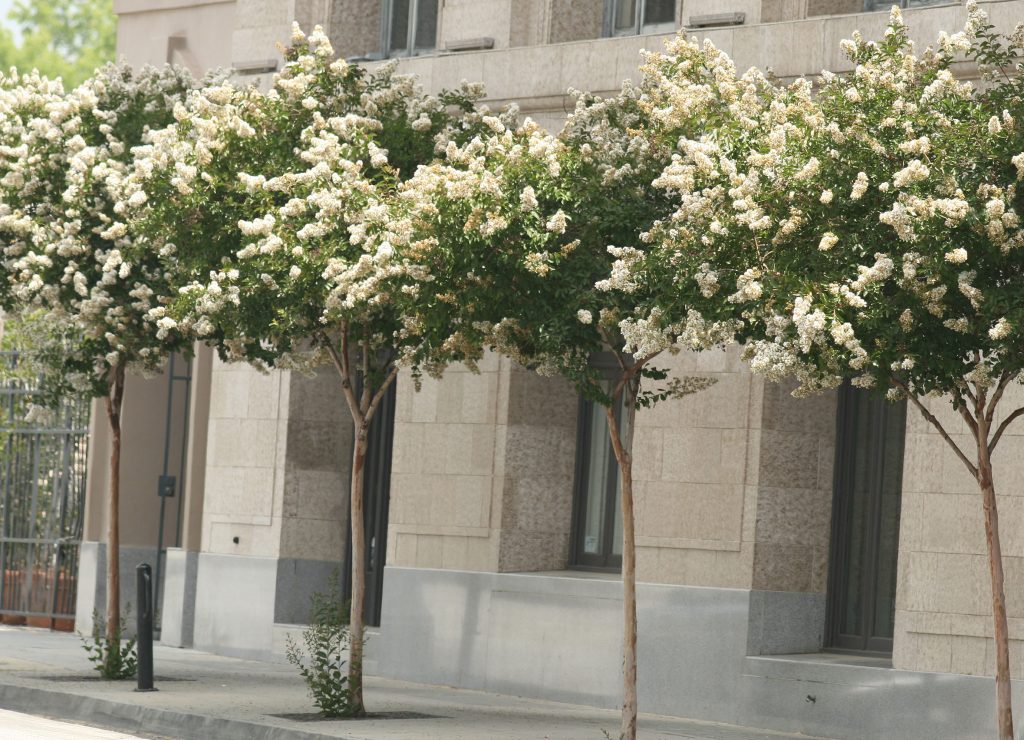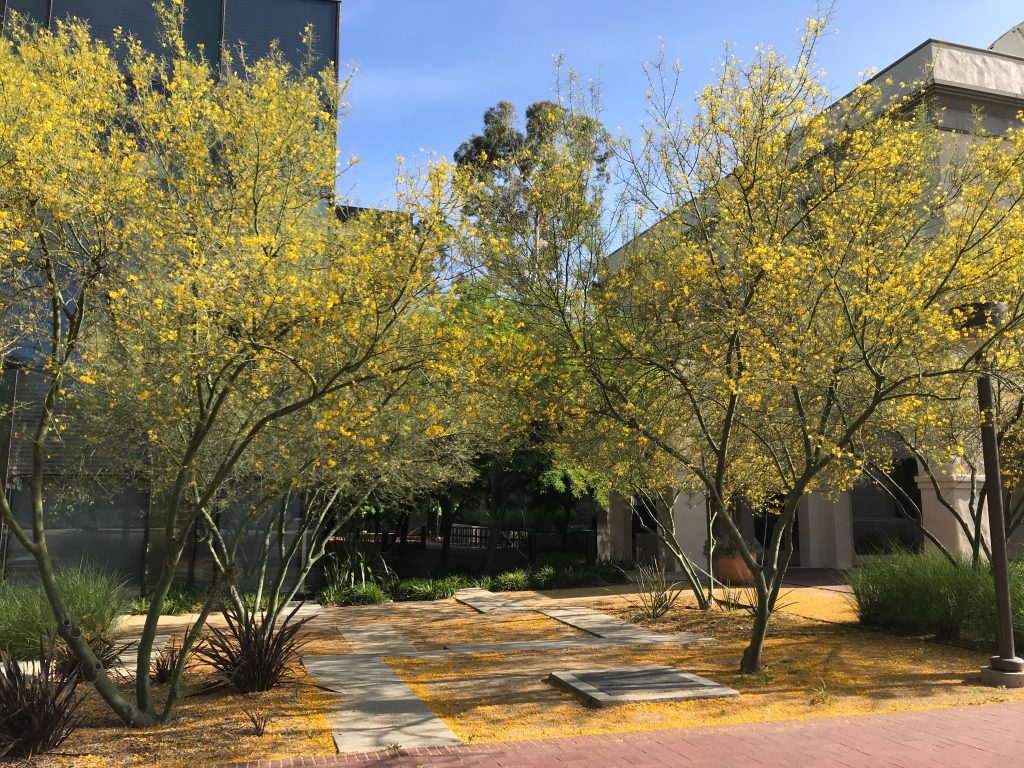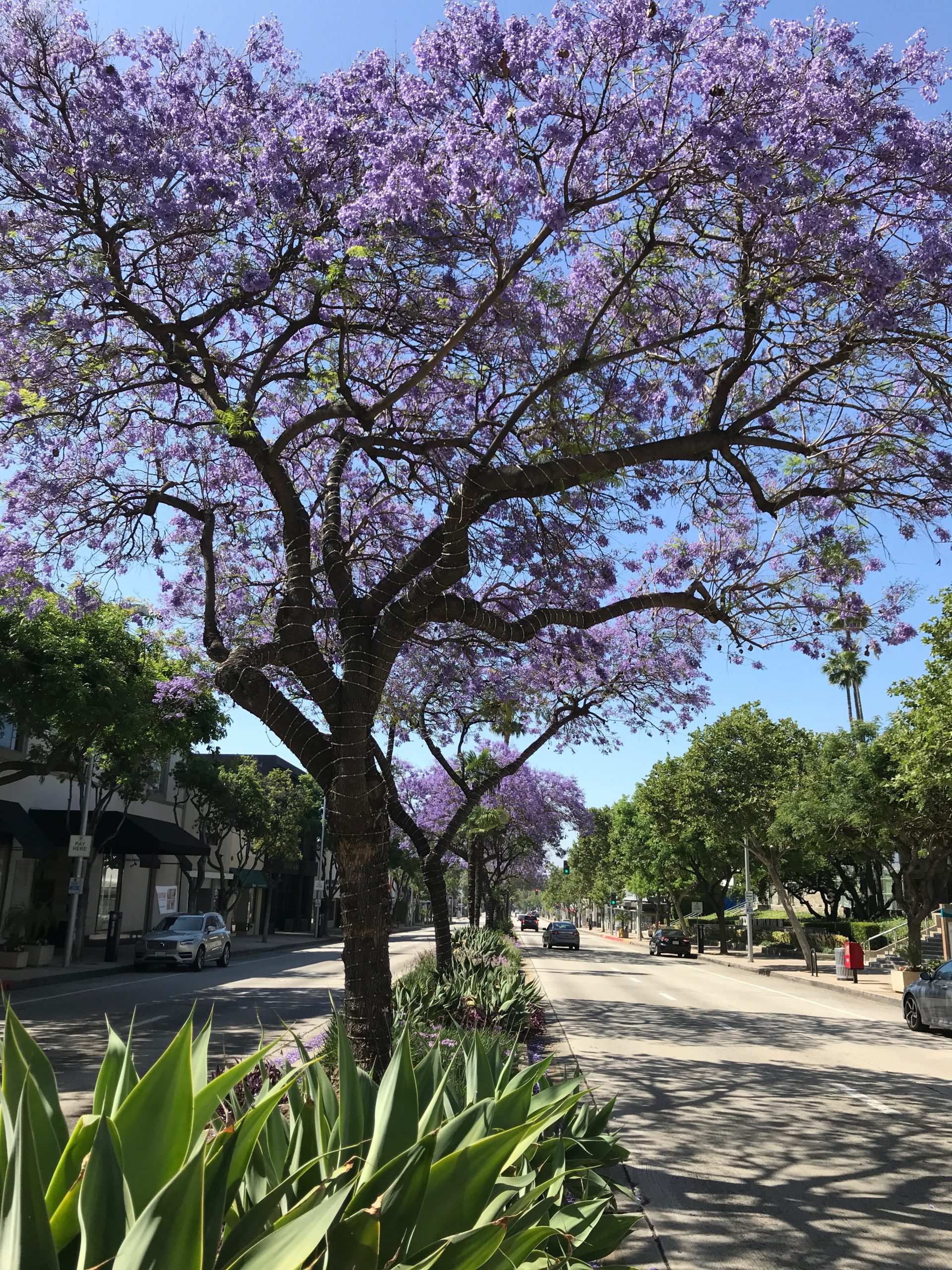September Tree of the Month
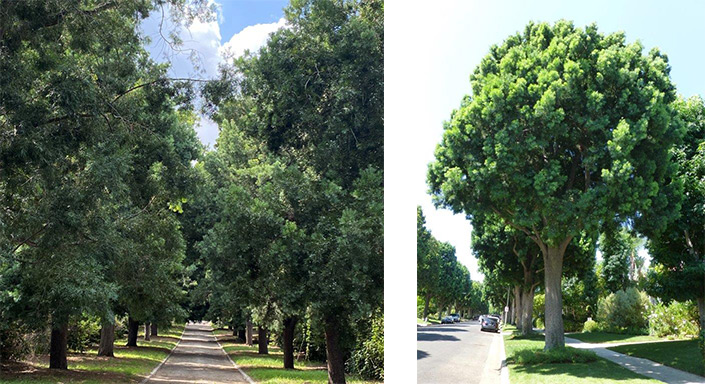
Afrocarpus falcatus – African fern pine
Calling this tree a pine or a fern is a misnomer as it is neither.
The tree belong to the Podocarpaceae family, is native to Eastern Africa and can be found growing in Ethiopia, Kenya Uganda and Tanzania.
The name was changed to Afrocarpus falcatus when the tree was removed from its original genus of Podocarpus. You can still find this tree being sold at nurseries under the name of Podocarpus gracilior.
This is a medium to large evergreen tree with a rounded dense crown and a moderate growth habit reaching a height between 50 to 60 feet tall and 30 to 40 feet wide. It makes for an excellent shade tree. In its native African habitat, this tree is revered for its lumber.
The tree trunk is covered with a patchy multi-colored bark that tends to peel off.
The leaves are fern-like, soft, narrow, bright-green at first, turning dark gray-green as the tree matures.
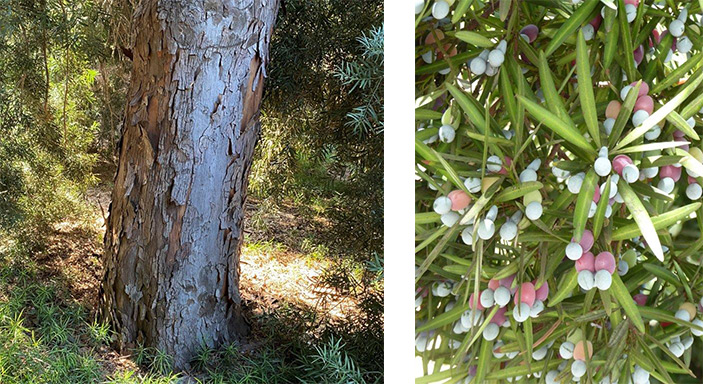
The Podocarpus gracilior is dioecious which means it has 2 genders both male and female. The female trees produce a fleshy fruit that is half an inch in diameter, green at first turning yellow then purple when mature. The fruit can create a nuisance when it drops.
The Podocarpus gracilior is a though tree that does well in our harsh urban environment. It requires very little maintenance. If you need to do some pruning to encourage new growth, do it in late winter or early spring. It is also a good idea to thin out the dense canopy from time to time to avoid branch breakage during high winds.
When used as a street tree the lower branches have to be removed for pedestrian and vehicle clearance.
The Podocarpus gracilior can also be used as a screening hedge.
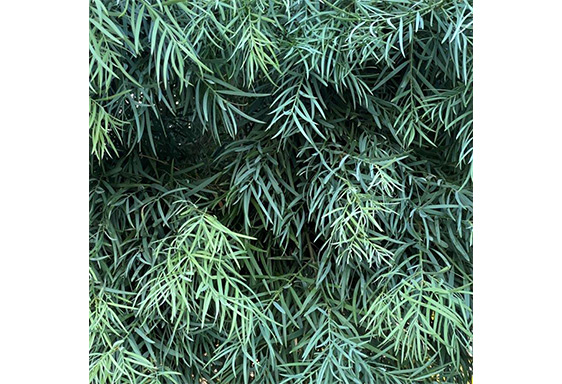
The tree performs better in full sun but can also grow in partial shade and thrives in many soil conditions. Avoid planting this tree in areas where frost is a problem.
The Podocarpus gracilior is sidewalk friendly with no known pests or diseases at the present.
When young, the tree requires regular watering becoming drought tolerant with maturity.
The Podocarpus gracilior is a very graceful and striking tree worthy of planting.
Article and photos by Emina Darakjy
August Tree of the Month
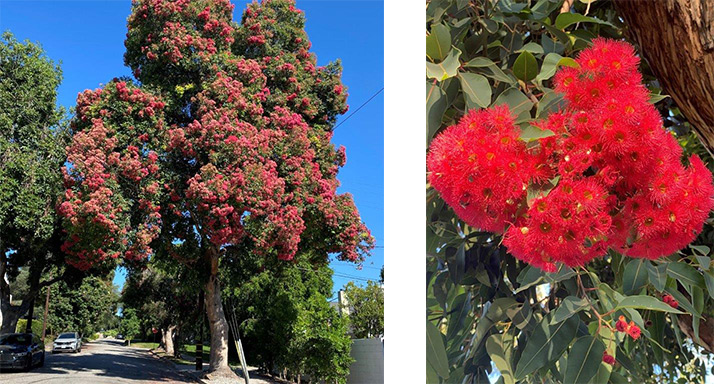
Corymbia ficifolia – red flowering gum
The Corymbia ficifolia belongs to the Myrtaceae family and is native to Western Australia. This tree was originally named Eucalyptus ficifolia by Ferdinand Von Mueller in 1860 and described in a book he wrote. In 1995 the name was changed to Corymbia ficifolia. This practice of changing names is common among Botanists.
This is an evergreen tree with a slow to moderate growing rate. It can reach a height between 25 to 40 feet with an equal or greater spread and with a dense canopy making it a good shade tree. This tree is also considered one of the showiest among the eucalyptus family.
The trunk of this tree is medium gray to red-brown with a fibrous and fissured bark that also covers the tree’s branches.
The leaves are attractive, ovate, thick, dark green on top and pale green underneath.
In late spring to early summer, the tree is covered with a dazzling display of vivid red clusters of flowers that last through September. Flowers can also be seen sporadically on the tree throughout the year.

It is important to note that because the Corymbia ficifolia is propagated from seeds and not cuttings, an exact flower color cannot be 100% guaranteed. There have been cases where the flowers come out vermillion- orange, rose and on some rare occasions creamy white. To make sure you end up with a vivid red color if that is what one prefers, buy a tree during the summer that is already blooming at a nursery. Regardless of what flower color you end up with, the trees always bloom profusely.
Following the flower display, clusters of persistent large gray-brown to reddish-brown seed capsules resembling urns appear. These capsules are very heavy and their weight can cause the branches to bend and break. It is recommended to remove them especially on young trees in order to avoid this problem.
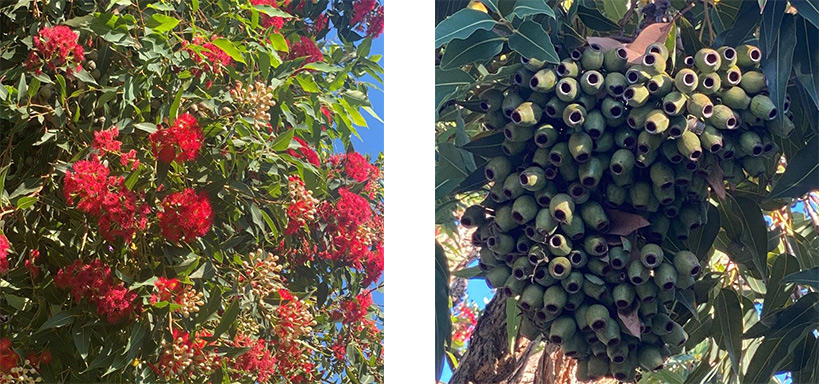
The tree is very hardy, prefers full sun and a well-drained soil. The Corymbia ficifolia does very well in our coastal regions from San Diego to San Francisco but does not tolerate cold weather. The tree requires regular watering at first and is considered drought tolerant once established. Damage to sidewalks from its roots is moderate. Keeping one’s tree healthy and stress free is the best defense against pests. The Corymbia ficifolia does very well as a street tree or in a park.
The tree nectar attracts all sorts of wildlife from bees to birds and butterflies.
If one wants to plant a stunning ornamental tree in one’s garden, the Corymbia ficifolia is an excellent choice.
Article and photos by Emina Darakjy
June/July Tree of the Month

Callistemon citrinus – lemon bottlebrush
The bottle brush is native to Eastern Australia and belongs to the Myrtaceae family. The name callistemon is derived from the Greek word meaning “Beautiful stamen”, and its common name bottle brush is attributed to the flowers that resemble bottle cleaners.
This bottle brush is a small size evergreen tree with a rounded canopy. It grows to a maximum height of 25 feet with an equal spread making it a good choice for planting underneath powerlines.
The leaves are narrow light green, simple, alternate and emit a lemon scent when crushed. In the spring to early summer and scattered throughout the year, the tree is covered with an explosion of clusters of brush-like bright red flowers with a nectar that attracts all kinds of birds and bees.
The fruit comes in the form of dark woody capsules that follow the flowers and tend to stay on the tree for a long time. These capsules contain small seeds that are adored by wildlife.
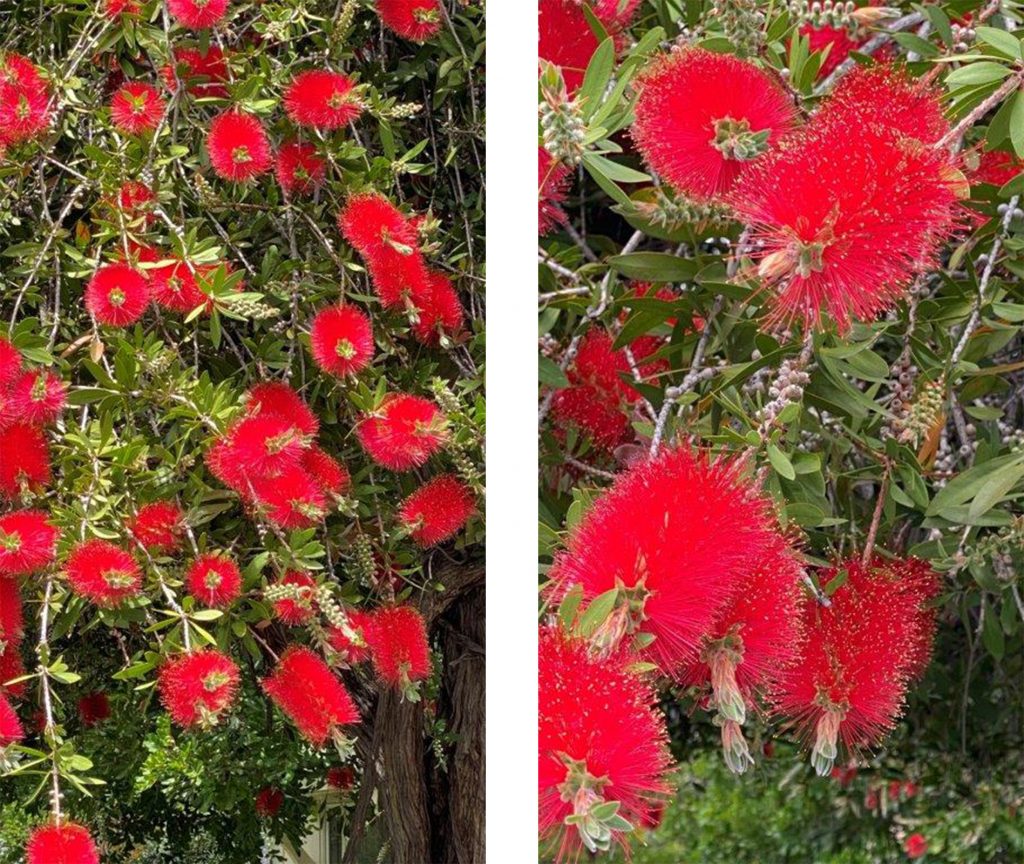
The bottle brush is a tough tree with no known pests or diseases at the present. It tolerates many soil conditions but does better in a well-drained soil. It prefers a sunny location but can take some partial shade. This is a simple tree to grow that only requires an occasional light pruning when needed.
There are many species and cultivars in the bottle brush family. The two most commonly planted ones in our area, are the Callistemon viminalis which has a very distinctive look due to its weeping form and the Callistemon citrinus described in this article.
The bark of the bottle brush is light-gray, furrowed and tends to peel off. This is a tree that is well suited for planting in a parkway and medians . Damage to sidewalks from its roots is minimal. This tree is also deer resistant if this is a concern in your area.

Due to its stunning display of vivid red flowers that last for a very long period of time, the Callistemon citrinus is a very popular tree to plant as a single trunk or as a shrub.
Some people may object to the litter caused by its flowers when they drop. I view this as a sign of a “living tree” doing what it is supposed to do.
Article and photos by Emina Darakjy
May Tree of the Month
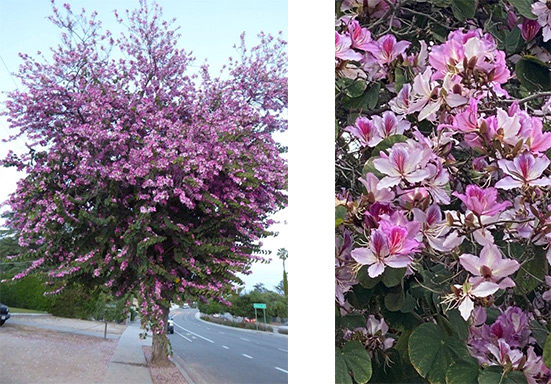
Bauhinia x blakeana – Hong Kong orchid tree
The orchid tree is a member of the Fabaceae Family (legume) one of the largest known plant family. This tree is native to China and Hong Kong.
The orchid tree is a fast-growing small evergreen to semi-evergreen tree, reaching a height of 20 to 30 feet with an equal spread. Under optimum conditions this tree can grow to a height of 40 feet.
The genus name Bauhinia pays homage to 2 Swiss botanist brothers from the sixteenth century, Johann and Casper Bauhin, and the epithet name blakeana honors Sir Henry Blake who was Governor of Hong Kong from 1898 to 1903.
The leaves are kidney-shaped, double-lobed, alternate and simple, blue-gray on the top and light green underneath. The trunk bark is gray and smooth.
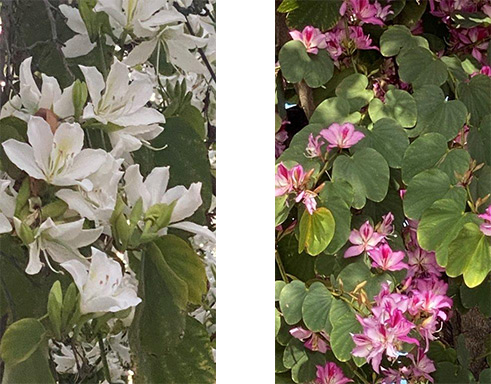
In late spring to early summer the tree is covered with clusters of dazzling fragrant flowers in a variety of colors from white to pink and purple. The flowers resemble cattleya orchids thus the tree’s non-botanical name. The flowers attract butterflies and bees, are very delicate and fall off easily. The flowers are followed by flat and long seed pods that resemble beans.
The orchid tree performs better in full sun but can tolerate light shade, prefers a well-drained soil and is considered drought tolerant once established. This tree is widely planted in Southern California because of the warmer weather and is rarely found in areas where freezing occurs.
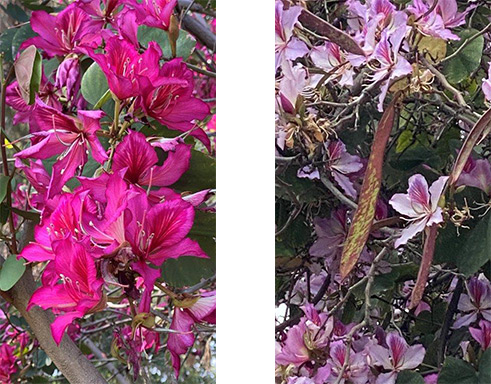
The orchid tree can be grown as a multi-trunk when used in a park or in one’s garden, or trained as a single trunk when planted as a street tree. Damage to the sidewalks from its roots is very minimal. This tree does not require a lot of maintenance. If you need to do any pruning to shape the tree, do it after the blooms are gone.
Presently there are no known serious diseases or pests affecting this tree, however aphids can be a problem.
When in bloom, the orchid tree is considered one of California’s showiest flowering trees and worthy of being planted.
April Tree of the Month
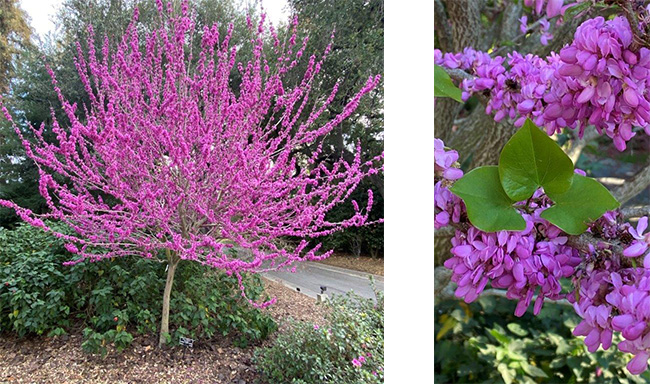
Cercis canadensis – ‘Forest Pansy’ eastern redbud
All varieties of redbuds belong to the legume family (Fabaceae). The eastern redbud is native to the Eastern United States and is found growing in many areas across the country. This tree is not to be confused with the Cercis occidentalis commonly known as the Western Redbud and is native to California.
The Eastern Redbud is a large shrub or a small to medium size deciduous fast -growing tree reaching a height of about 25 feet to 35 feet with a short trunk and a rounded crown.
The trunk/bark is grayish-brown, smooth when young becoming fissured and scaly as the tree matures.
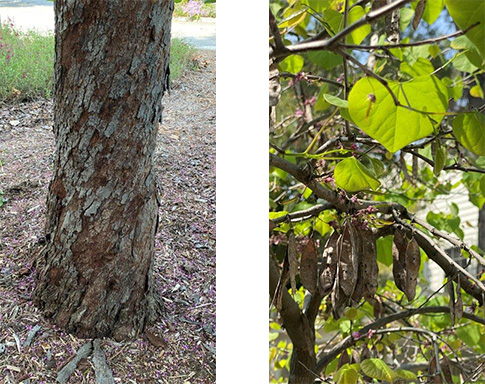
The leaves are simple alternate, heart-shaped with a pointed tip. The leaves are shiny green when they first come out changing to red and orange in late summer. The leaves of a cultivar called ‘Forest Pansy’ are maroon color.
In the spring, from March to May and before the leaves come out, clusters of bright mauve-pink flowers are borne on bare branches including parts of the trunk. The flowers are shaped like tiny peas, serve as good pollinators and are followed by flat paper-thin green seed pods, before they turn dark brown and split open releasing their seeds.
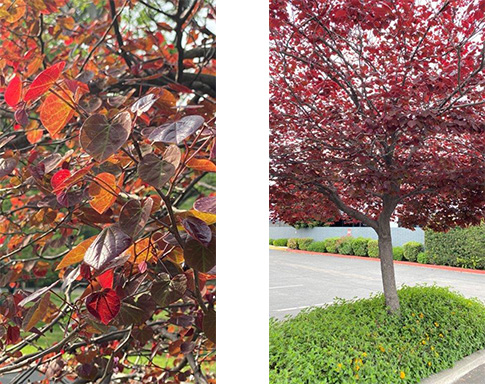
The Eastern Redbud is easy to grow, requires low maintenance, prefers a well-drained soil, moderate watering, full sun to partial shade, and has no known pests or diseases.
The Eastern Redbud is very often grown as a multi trunk but can be trained to be a single trunk. This tree is rarely planted as a street tree. Because of its spectacular flowers it is an excellent choice as an ornamental tree in a park or in one’s garden.
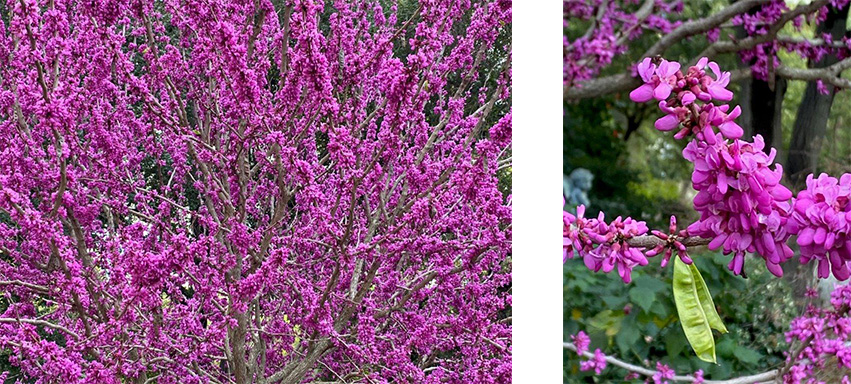
There are several species within the Redbud family, the one called ‘Forest Pansy’ is the better suited one for California.
In 1937, the eastern redbud was officially designated as the state tree of Oklahoma where you can find it wildly growing on hills and valleys throughout the state.
It is also said that Native Americans enjoyed eating the flowers and buds of this tree and used its bark to make medicine to treat various ailments with.
With all the many spectacular flowering trees around us, if you are looking for that extra ‘Wow Factor’ the eastern redbud is the tree for you.
Article and photos by Emina Darakjy
March Tree of the Month
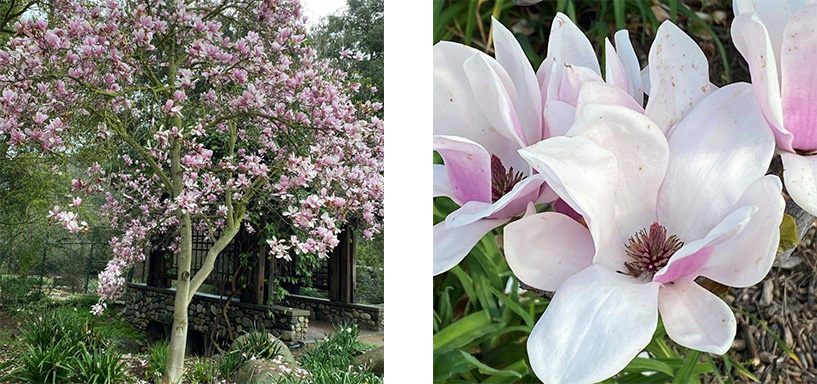
Magnolia x soulangeana – Saucer Magnolia
This tree is also called the Chinese Magnolia or the Japanese Magnolia.
This tree is from the Magnoliaceae family and is native to France and Japan.
This is a small to medium size deciduous tree reaching a height of 20 to 25 feet tall and as wide. The tree is a hybrid magnolia that was bred by crossing two Asian magnolias by a French botanist by the name of Etienne Soulange-Bodin in 1826 at his Chateaux de Fromont near Paris.
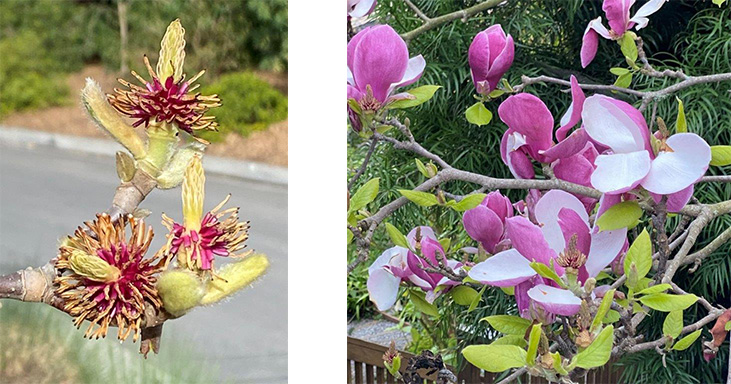
For months before the flowers appear, tree branches are covered with fuzzy buds emerging from velvety leaves apple-green in color, alternate and oval. In late winter to early spring, these buds develop into large, waxy and sweet-scented blooms appearing on bare branches. The blooms are tulip shaped at first, opening to a saucer form to expose the prominent stamens. The flowers range in color from white to shades of light pink and deep purple. When in bloom this tree is so spectacular looking providing a focal point in a park or in one’s garden.The trunk is smooth and silvery-gray.
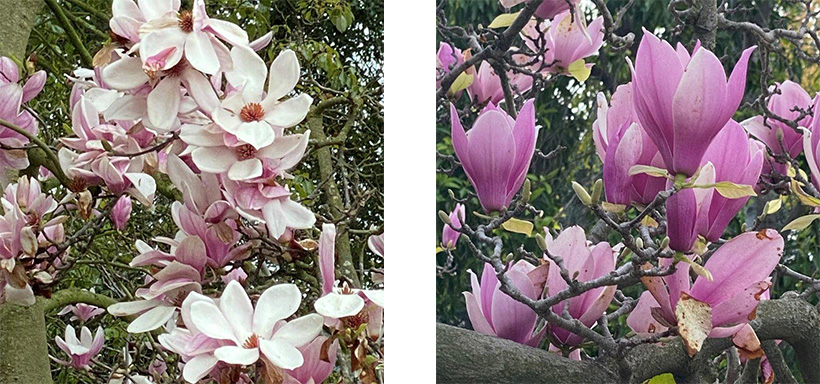
The tree does best in full sun, prefers rich and moist soil but is considered drought tolerant once established. The tree is known to tolerate pollution and can survive a colder climate.
The Saucer Magnolia can be grown as a multi trunk with low branching or trained as a single trunk. Because of its small size, this tree is a good candidate for planting under power lines. It is also deer resistant. It attracts many pollinators and provides a good source of food for birds who like to build their nests in its branches.
The tree is very easy to care for and there are no serious known pests or diseases to worry about. Litter from the flowers can be a problem though.
If you are looking for a magnificent ornamental tree that shouts “Hello Spring” the Saucer Magnolia is the one.
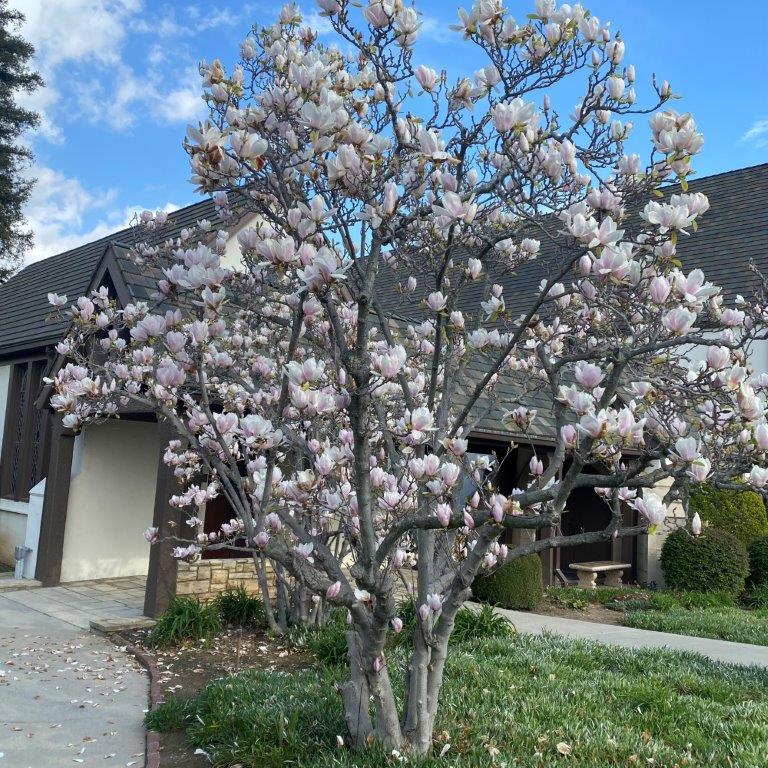
Article and photos by Emina Darakjy
February Tree of the Month
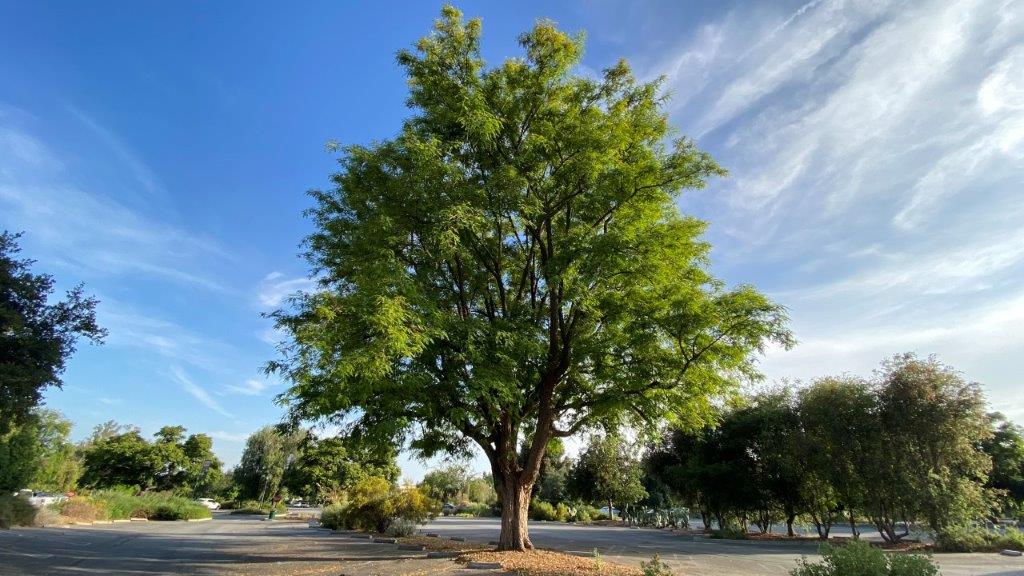
Tipuana tipu – tipu tree
This tree is a member of the Fabaceae family (pea family). It is found in Bolivia, Argentina and the southern region of Brazil. The tipu tree is a moderately fast-growing tree, can reach a height of 60 feet with an equal spread which makes it a very good choice for a shade tree.
In the winter the foliage is deciduous for a brief period. Its leaves are a vivid shade of green about 10 inches long, pinnately compound, with 11-12 leaflets. The trunk is very attractive, reddish-brown in color with fissured bark.
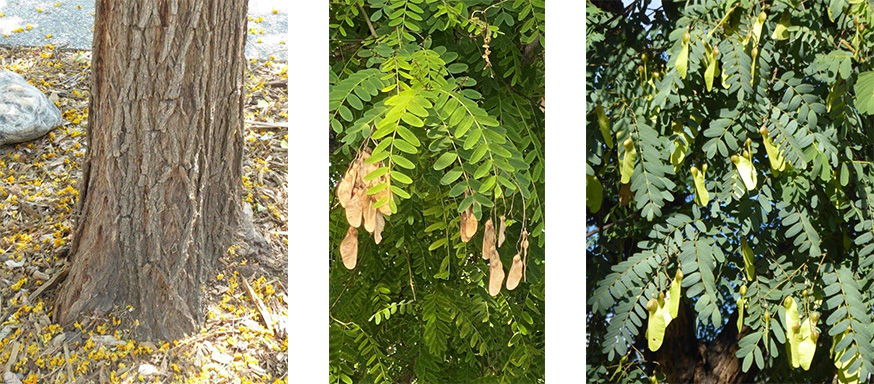
The flowers appear in early spring and last through the summer, they are a striking shade of yellow to apricot. When they drop off, the flowers form a dazzling gold carpet underneath the tree canopy. Some people may see this as a nuisance while others view it as an attribute. Fruit resembling a bean pod with flat wings appear in the summer. The pods twirl when cascading to the ground.Even though they are non-fragrant, the flowers manage to attract many bees and butterflies. Birds like to nest in the tree’s thick canopy. The tree is considered deer resistant.
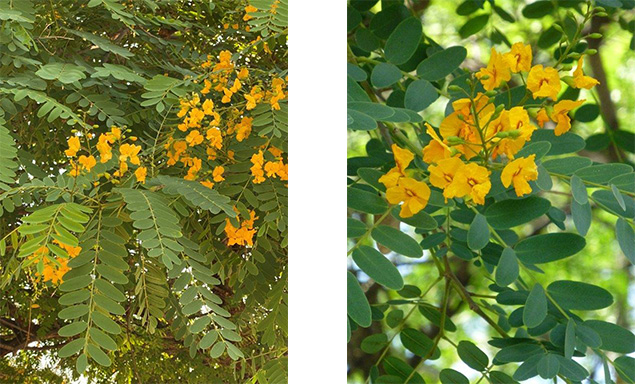
The tipu tree is widely planted in the warmer regions of California, tolerates many soil conditions, but performs better in a well-drained soil and likes a sunny to partial sun location. The tipu requires deep watering when young but once established, it is fairly drought tolerant.
The tipu tree needs ample room to grow. It can be planted as a street tree, in medians or in a park. Its roots are aggressive and can cause damage to sidewalks. The tree is susceptible to aphids, psyllids and scale infestations.
Because of its large size, this tree is not suitable for under power lines.
When looking for a large tree that provides plenty of shade especially in a park, look no further than the tipu.
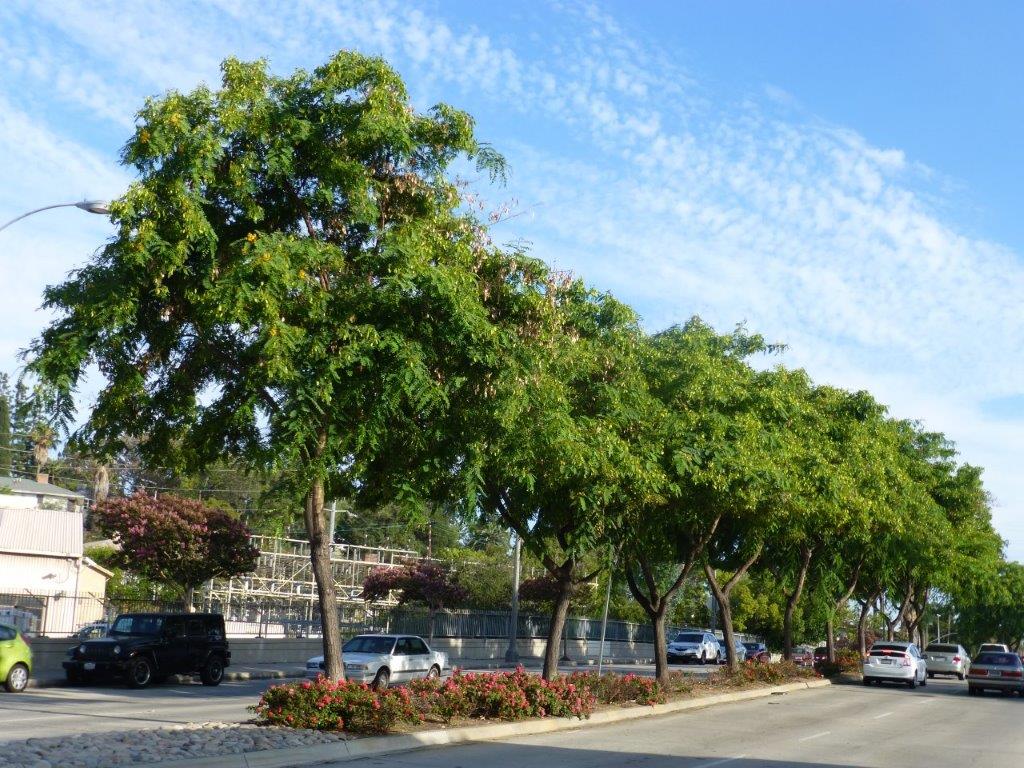
As a side note: In 2017 a tipu tree was nominated and listed as a Champion Tree on the California Big Tree Registry. This particular tree is growing in Goleta. The tree measures 55 feet high, with a trunk circumference of 197 inches and a crown of 113 feet and received a total of 280.25 points.
Article and photos by Emina Darakjy
January Tree of the Month
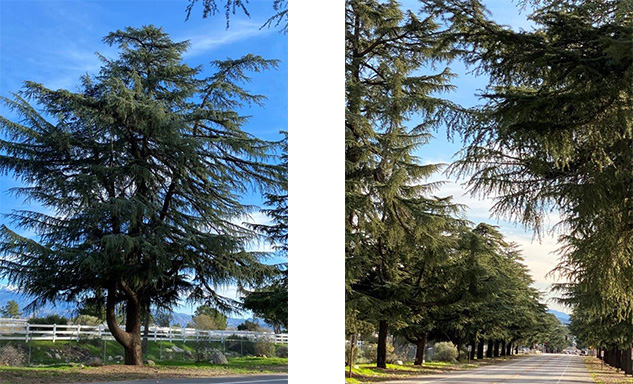
Cedrus deodara – deodar cedar
The deodar cedar is a member of the Pinaceae family and is native to the Himalayas thus, its other name “Himalayan cedar”. In the ancient language of Sanskrit, the word deodar means “tree of the Gods”.
This tree was first introduced to Europe in 1822 and to the United States in 1832. This is a large fast growing evergreen tree, reaching a height of 40 to 80 feet with a spread of 30 to 40 feet. The tree trunk is very straight, the bark is dark gray turning scaly and deeply furrowed as the tree matures. The arching branches drooping all the way to the base of the trunk are covered with 1-2” bluish-green needles giving the tree a stately look. The crown of the tree is a pyramidal shape.
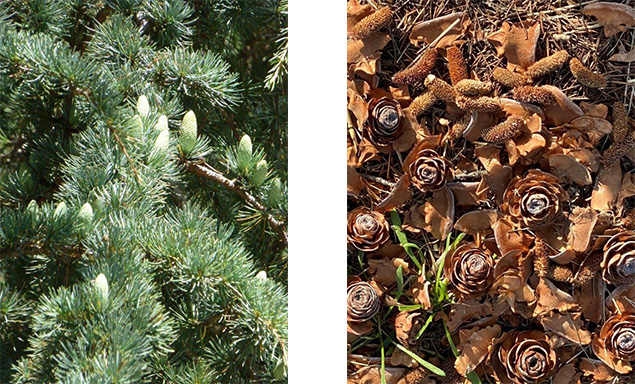
In the spring unnoticeable flowers appear followed in late summer by cones that grow upright on the branches and can take up to 3 years to mature before they open releasing winged seeds. The tree produces an aromatic oil that deters insects. In India the deodar cedar wood is revered for its durability and is used in different carpentry and woodworking projects as well as making incense.
The deodar cedar grows easily in any type of soil with good drainage and is considered drought tolerant once established. It performs better in full sun to partial shade with ample room to grow and tolerates both the heat and the humidity. This tree requires very low maintenance but benefits from an occasional structural pruning every now and then to remove any dead wood or crossing branches. Avoid excessive irrigation as this can cause root disease.
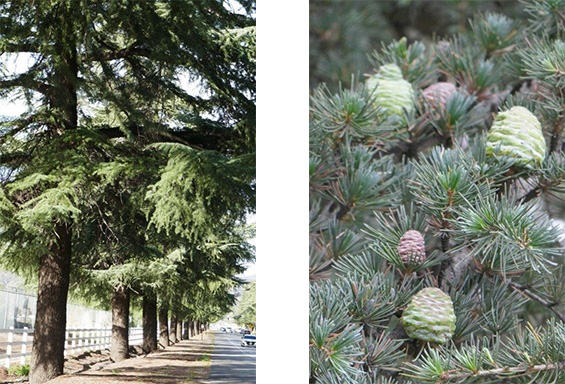
This tree makes a good landscaping specimen in a park, in ones’ garden or as a street tree. When used as a street tree the lower branches are removed for pedestrian clearance. Many neighborhoods tend to string thousands of colorful lights on these trees at Christmas time which draws many visitors to them. Two such neighborhoods that come to mind are “Christmas Tree Lane” in Altadena where these trees were planted in 1882 and on St. Albans Road in San Marino.
However, for me one of the most beautiful double planting of deodar cedar trees remains the one on Beaumont Avenue in Beaumont where for a mile and half you can find more than 115 of these majestic beauties gracing that Avenue. These trees were planted in 1930 and serve as a windbreak. Finding yourself driving through a tunnel with an overhang of drooping branches is a sight to behold.
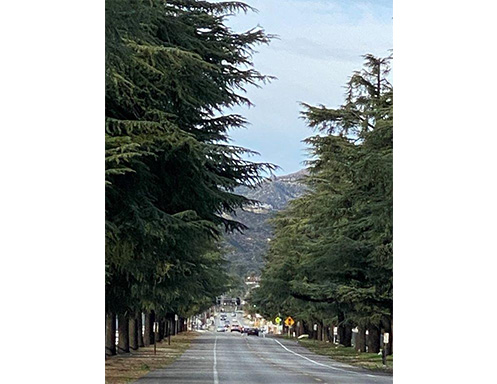
2022
December Tree of the Month
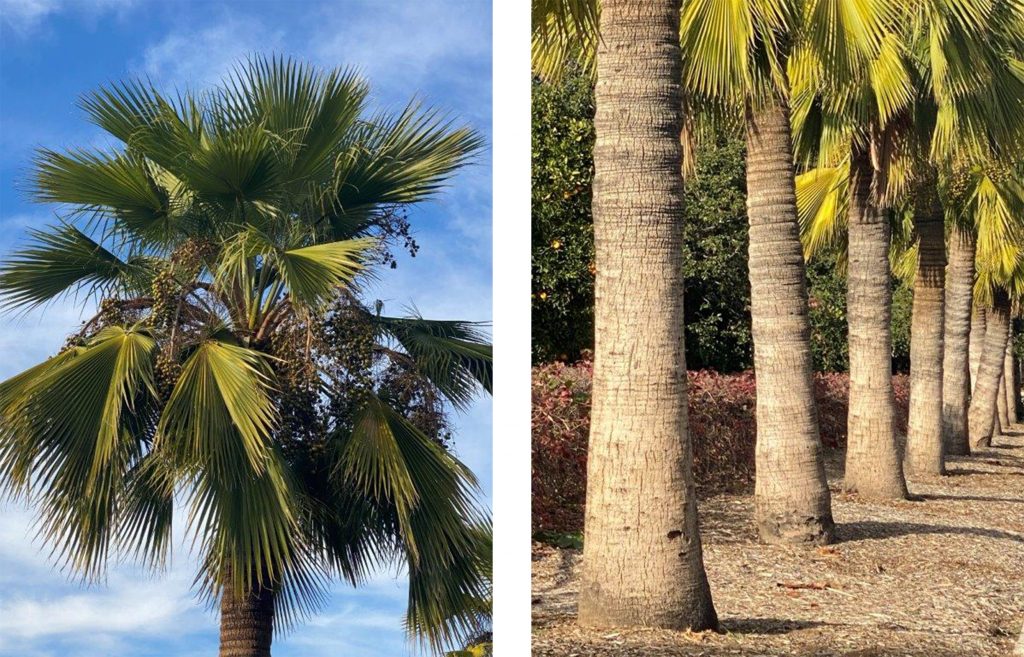
Brahea edulis – Guadalupe palm
Family: Arecaceae
Origin: Native to Guadalupe Island and Mexico
The Guadalupe palm is a slow-growing palm that can reach up to 30 feet tall with a 20 foot spread. The trunk is light grey in color, highly fissured, and exhibits horizontal ridges. It self-cleans itself giving it a smooth appearance.
The foliage is evergreen, palmate, and light vivid green year-round. Unlike other palm varieties, the Guadalupe palm does not require pruning because the dead leaves (fronds) drop off on their own. It also does not have a skirt. The fronds of this palm are very large and smooth giving it a dramatic and exotic appearance.
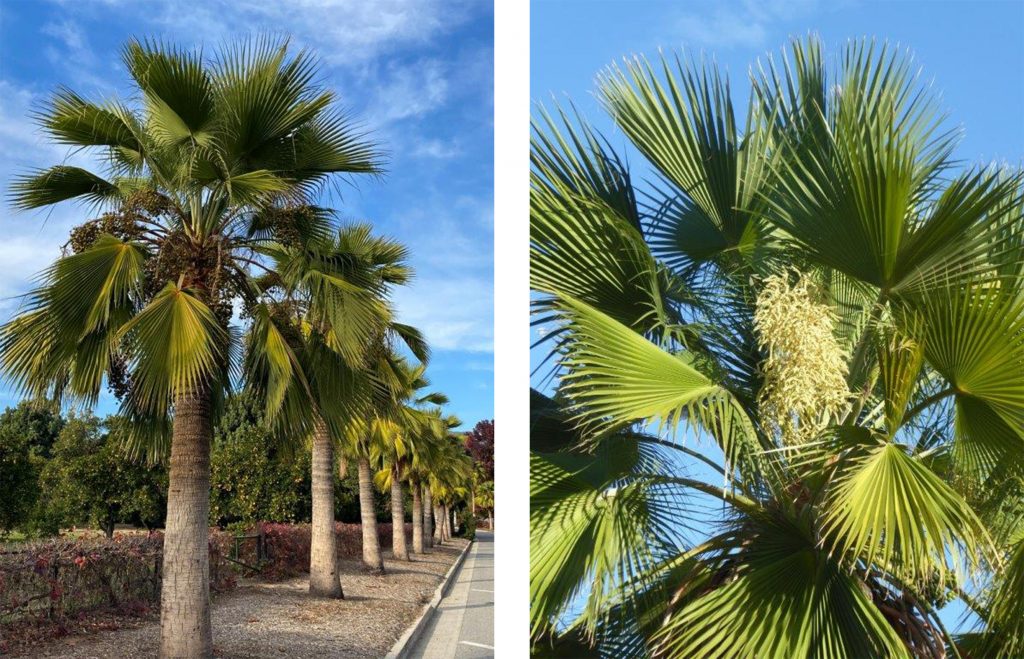
The flowers are perfect, meaning they contain both male and female parts. They are cream-colored, fragrant and appear in March. The large clusters of round edible fruit that follow are green at first, turning yellow, then dark black when ripe. The fruit has a sweet molasses taste, and is sometimes compared to dates.
The Guadalupe palm is cold hardy, allowing it to grow in places like Georgia and Washington. It tolerates poor but dry soil conditions. It requires full sun and can withstand both wind and drought conditions. The Guadalupe palm can be planted in narrow parkways 2 – 3’ feet wide and is suitable for planting under power lines because of its slow-growing habit. It is a beautiful palm when planted as a street tree in parkways, medians, in a park, or a garden.The Guadalupe palm can be propagated from seeds and is not susceptible to any known diseases or pests.
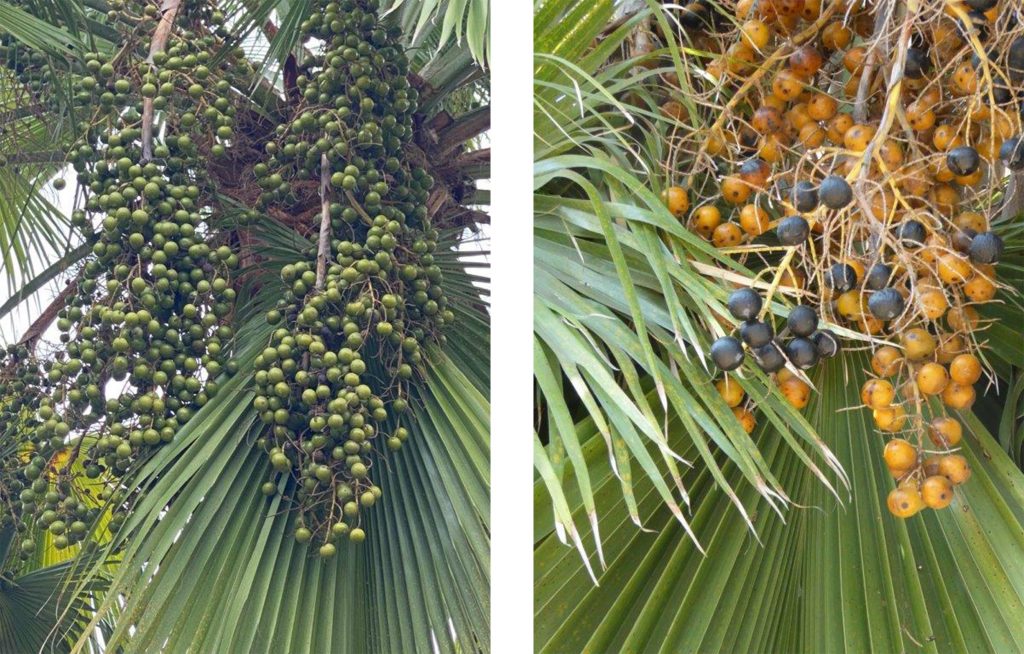
Unfortunately, this palm is becoming almost extinct in the wild as a result of the non-native goats that were brought to Guadalupe Island in the 1800’s by early European settlers. The goats escaped and their numbers grew quickly. To survive, they started eating not only the fruit when it dropped to the ground but they also would devour all the ones that managed to sprout. Since 2005 the Mexican Government has embarked on a large-scale effort to try and eradicate these goats in order to preserve these palms and all other vegetation on the island.
Article and photos by Emina Darakjy
November Tree of the Month
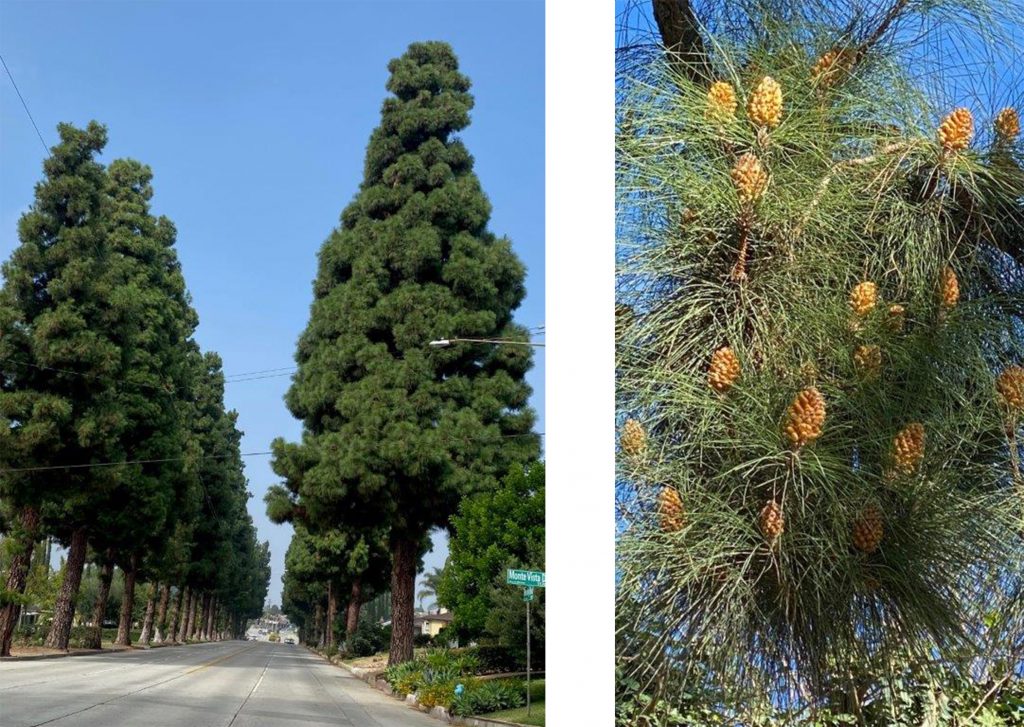
Pinus canariensis – Canary Island pine
Family: Pinaceae
The Canary Island pine is a member of the Pinaceae family and is native to Spain’s Canary Islands in the Atlantic Ocean off the coast of Morocco.
This is a large evergreen conifer. It is fast growing, and can reach a height of 80 plus feet with a spread of 25- 40 feet.
When young this tree looks very gawky, developing a conical crown as it gets older. Its branches are covered with blue-green soft needles that turn dark green with age. In the Canary Islands where this tree is from, the soft needles are used as packing material when shipping bananas.
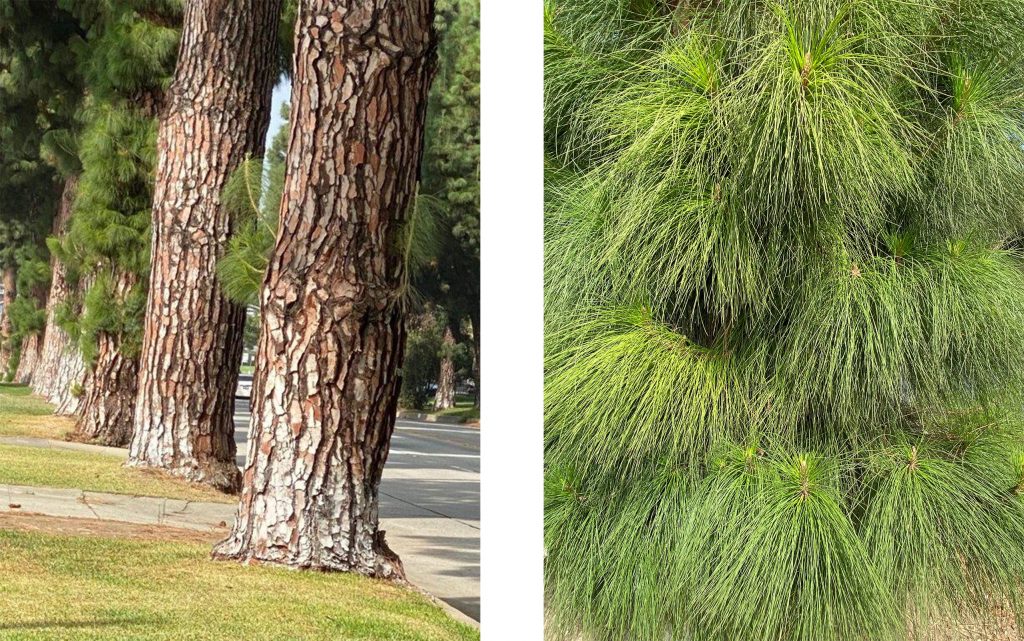
The trunk of this tree is very attractive with a reddish-brown and fissured bark. The bark is very durable and as the tree grows older more layers of bark form, making the tree resistant to wildfires. The tree can also easily re-sprout after being burned. The Canary Island pine is valued for the quality of its wood which is used in construction and furniture-making.
The tree produces oval cones 5 to 7 inches long that are green at first and then turn glossy brown with age. The cones take about 2 years to mature. After 2 years the cones open up, releasing pine nut seeds that are a good source of food for many small animals such as squirrels.
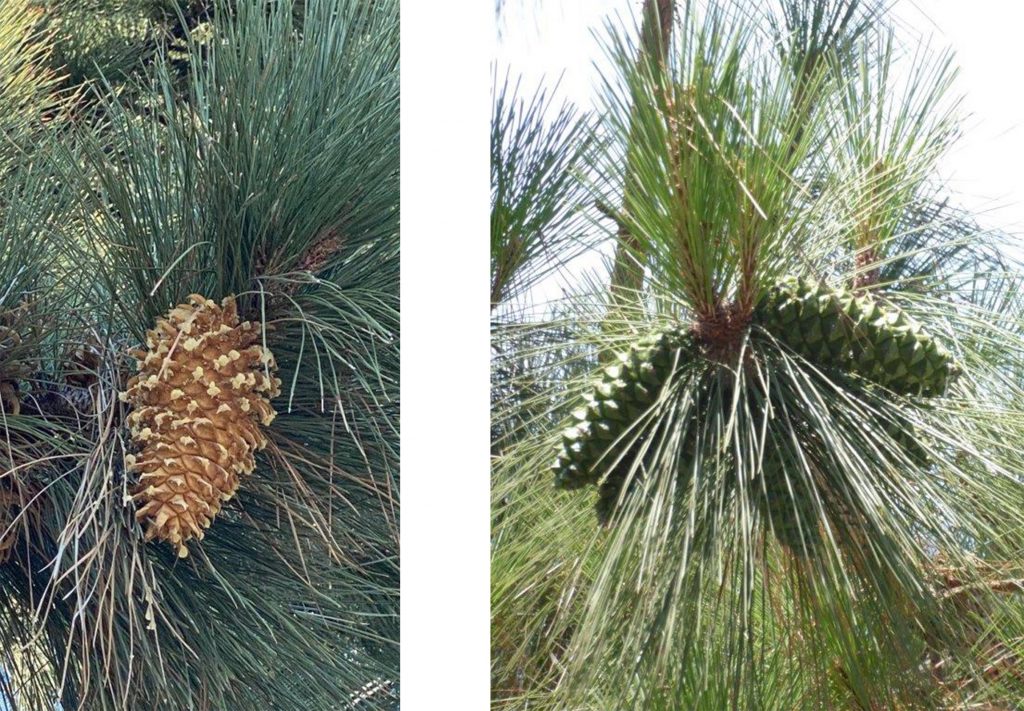
The Canary Island pine requires a parkway width of 10 feet, and the damage to sidewalks from its roots is moderate. It performs better in a sunny location and requires very low maintenance It can tolerate almost any type of soil with good drainage, and is drought tolerant. Applying too much water can kill the tree. The Canary Island pine is susceptible to beetle borers and aphids but is resistant to Oak root fungus.
The tree is an excellent choice for planting in yards, parks and as a street tree. Some cities, like Whittier and Beverly Hills, have streets that are completely lined with Canary Island pines. When driving along Beverly Boulevard in Whittier which has about 200 Canary Island pines growing on it, you can’t help but be in awe of these tall and majestic trees.
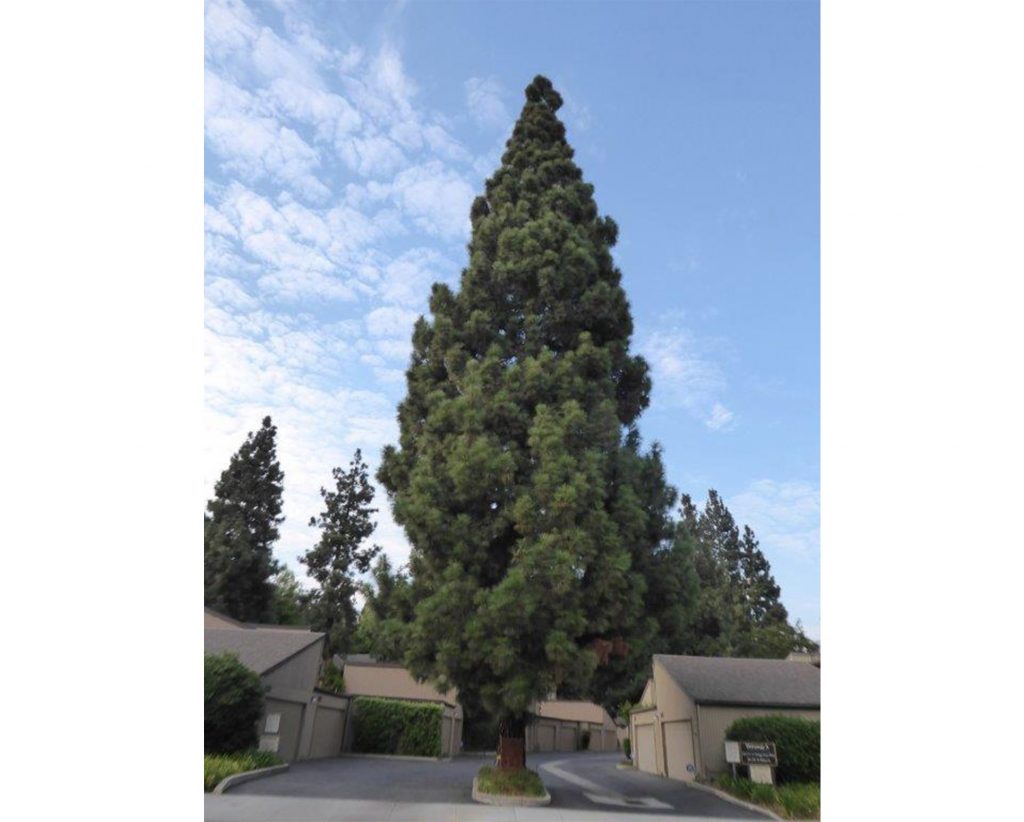
Article and photos by Emina Dara
October Tree of the Month
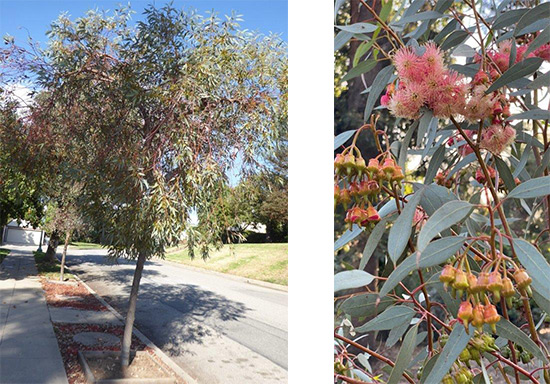
Eucalyptus torquata – coral gum
Family: Myrtaceae
This is a small evergreen fast growing tree in the Myrtaceae family. It is native to Western Australia and is considered an ornamental tree. The word eucalyptus comes to us from the Greek words “Eu”, meaning well, and “Kalyptos”, meaning well-covered, which describes the caps that cover the flowers.
The tree grows to about 20 feet tall with an equal spread. The leaves are alternate, spear-like, narrow and long, light gray to yellow-green. When the tree is young the branches are a pretty red color. The trunk/bark is rough, gray-black, and furrowed.
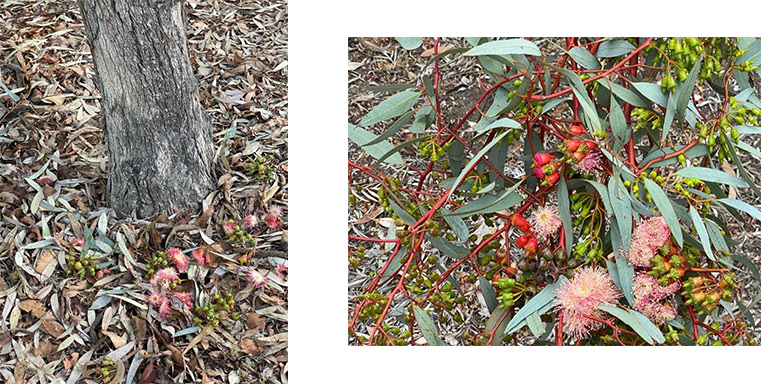
The tree blooms from October through early summer. Colorful buds with caps that resemble tiny lanterns appear first. The caps then drop, exposing a dazzling display of dainty fringed flowers in shades of white, pink, red and coral.
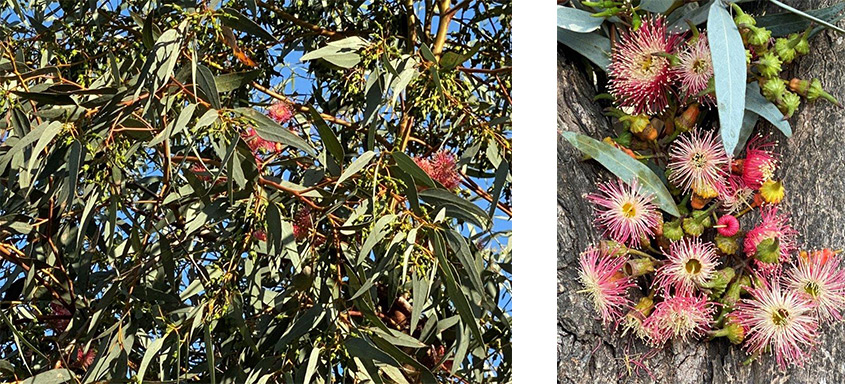
The Eucalyptus torquata is considered drought tolerant, can do well in any type of soil conditions, prefers full sun, and tolerates pollution. There are no significant pest problems to report at the present. Other than some staking and light pruning when the tree is very young, this tree requires hardly any maintenance after that.
The Eucalyptus torquara makes a good street tree even in very narrow parkway widths. It also makes a good ornamental tree in a garden, grown in a standard form, or as a large shrub. This is a beautiful, small, long-blooming tree that attracts bees, birds, butterflies, and all nectar-loving wildlife.
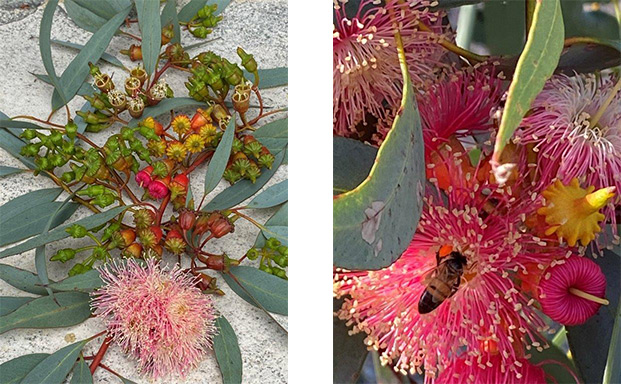
Article and photos by Emina Darak
September Tree of the Month
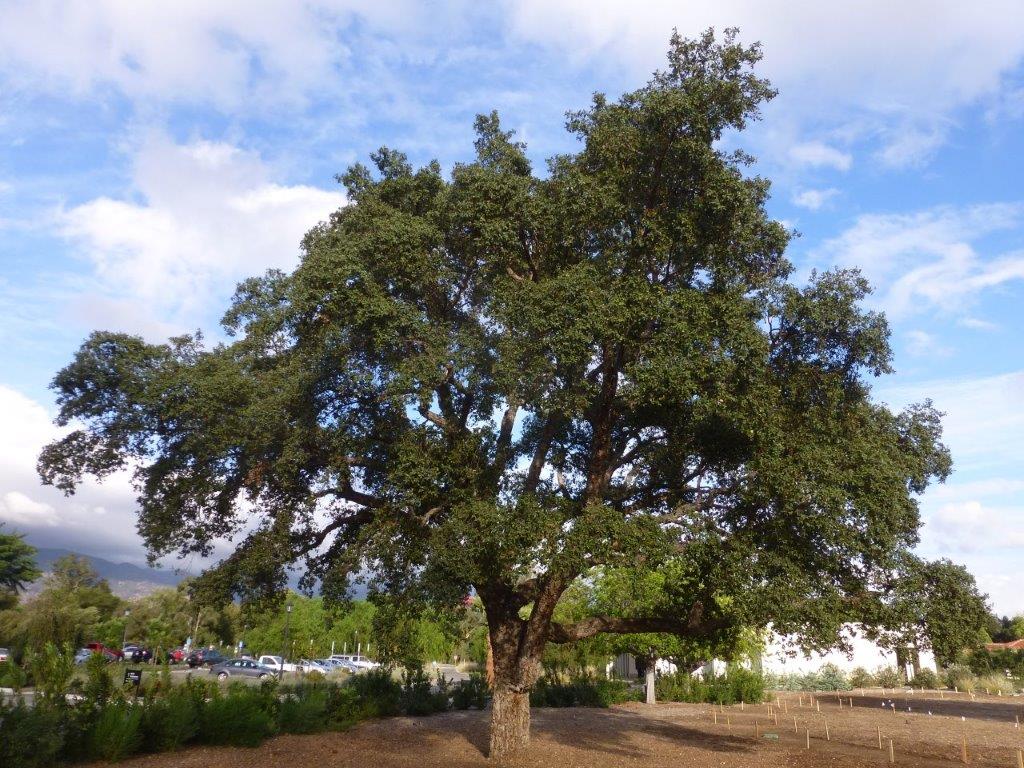
Quercus suber – cork oak
Family: Fagaceae
The cork oak is a member of the Fagaceae family and is native to Southern Europe and Northwestern Africa. The botanical name “Quercus suber” is derived from the Latin words: “Quercus” for oak tree and “suber” for cork.
This is a medium sized evergreen tree that can reach a height of 40-50 feet with a spreading canopy up to 60 feet wide. It can live for more than 200 years.
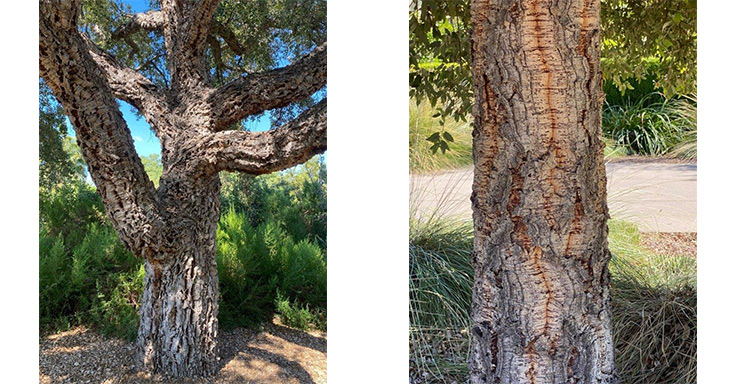
The trunk is very unusual looking, with a light grayish-brown thick layer of spongy bark with vertical fissures that are white on the outside and reddish brown on the inside. The trunk is the main characteristic feature of this tree.
In some countries like Spain, Portugal and Morocco where very large forests of cork oak exist, this tree is grown for the sole purpose of producing, harvesting and commercially selling cork which is a natural product used to make wine bottle stoppers as well as all types of flooring, insulation, and household articles.
The harvesting of the cork begins when the tree is about 20 years old and continues in intervals of 9 to 10 years. This is done by making a cut to the layer of bark that covers the trunk and stripping it away. This does not kill the tree or cause any damage to it. After the stripping is done the trunk looks smooth and reddish brown then turns darker and starts growing another layer of bark. This process continues for more than 100 years.
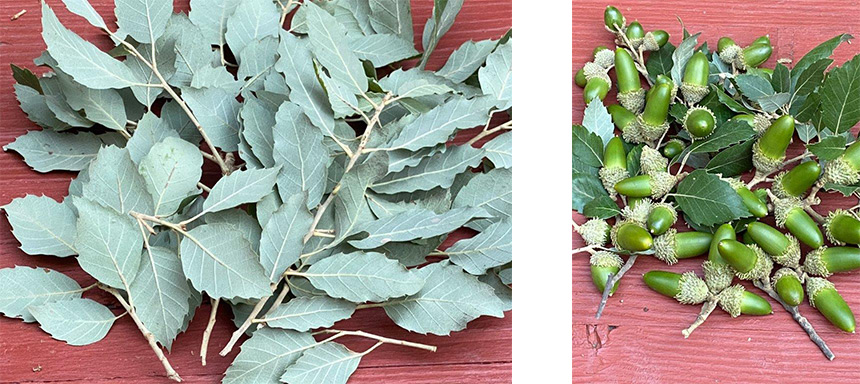
The leaves are alternate, ovate, serrated, and glossy dark green on the top. Also, the leaves are very pale gray with distinct hairy veins underneath.
The acorns of the cork oak are oblong with beautiful cream-colored frilly caps that cover as much as one third of the acorns.
Once established the cork oak is considered drought tolerant but can benefit from occasional deep watering. It does well in most types of soil with good drainage and prefers full sun but can tolerate some shade.
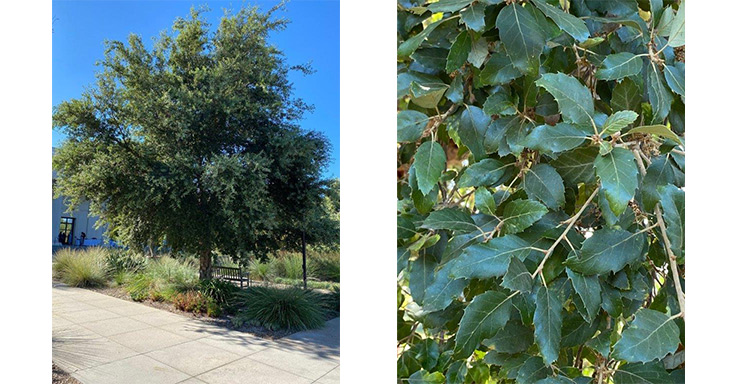
The cork oak in California is grown as an ornamental tree, and requires a larger parkway/cutout of 7-feet. It can be planted as a street tree, in a park or in one’s garden with ample space. Damage to the sidewalks from its roots is minimal. Pest to worry about are root diseases, California oak worm and the polyphagous shot hole borer (PSHB).
When using mulch, please make sure to keep it away from the tree trunk and re-direct your sprinkler heads away from the trunk. Using drip irrigation is the preferred solution to watering trees. Lastly, never put decorative arroyo boulders or stones underneath the tree as this tends to cause compaction to the soil and keeps it very moist which is not a good thing for any tree and especially not the oak species.
On a side note, I was fortunate to grow up near one of the largest cork oak forests in the world called the Mamora Forest, outside of Rabat, the Capital of Morocco. I have very fond memories of piling up in the family car every Sunday to go for a picnic underneath these remarkable trees and surrounded by carpets of beautiful flowers.
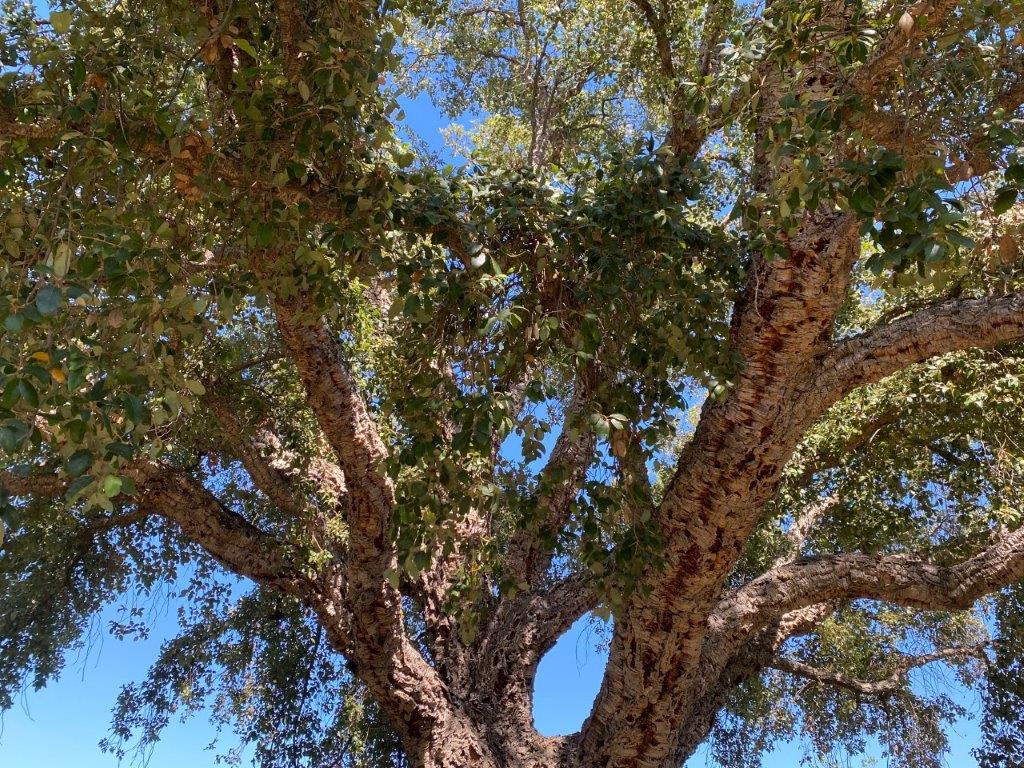
Article and photos by Emina Darakjy
August Tree of the Month
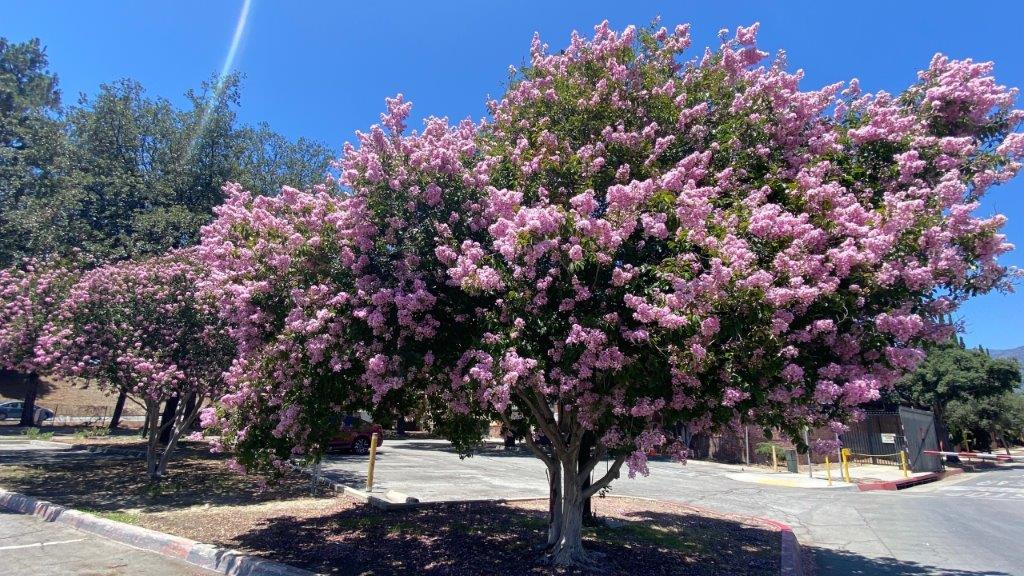
Lagerstroemia indica – crape myrtle, also spelled crepe myrtle
Family: Lythraceae
The crape myrtle is a small to medium size deciduous tree, native to China, Japan and the Indian subcontinent and was introduced to Europe in 1759 from China. In the sixties, several different hybrids of this tree were developed at the U.S. National Arboretum in Washington D.C.
The tree can reach a height of 20 to 30 feet tall with a 10 to 20 feet spread. The shape of the crown varies depending on the cultivar. The trunk is very smooth with an exfoliate thin bark exposing a surface underneath with blotches of tan, cinnamon, gray and pink colors. Leaves are opposite, glossy green and oval, turning yellow, red and orange in the fall prior to dropping off.
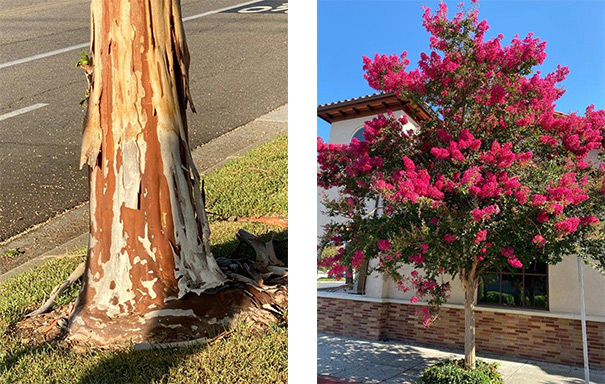
In late summer when few other trees are blooming, the crape myrtle is covered with showy clusters of cone shaped flowers with crinkled petals that resemble crepe-paper. The flowers come in a wide range of colors including brilliant shades of pink, violet, salmon, red and white. The crape myrtle is also considered one of the longest blooming trees anywhere. Woody brown seed capsules resembling little flowers themselves appear on the tree branches after the blooming period.
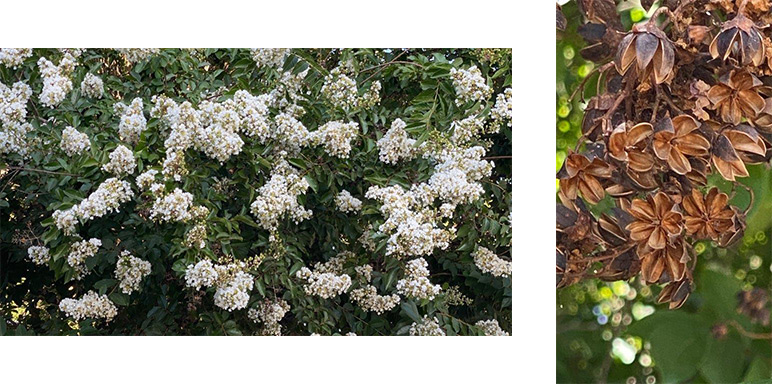
The crape myrtle prefers a sunny location and can do well in any type of soil including clay. It requires deep watering when young but less frequently as the tree matures making it moderately drought tolerant.
The crape myrtle is not suitable for coastal and foggy areas as this tends to cause mildew. The same problem occurs if the tree is planted in the shade. The following hybrids which were all developed at the National Arboretum: Arapaho with red flowers, Natchez with pure while flowers, Tuscarora with coral/pink flowers and the Muskogee with lilac flowers are all considered mildew resistant.
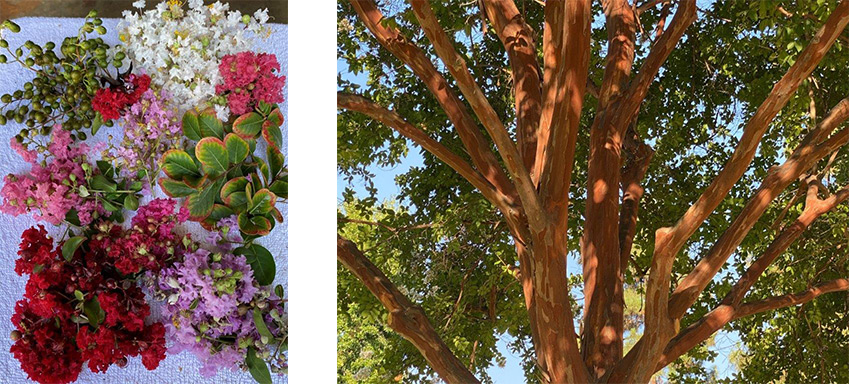
The crape myrtle is a very easy tree to grow. It requires pruning only for shaping or clearance when planted as a street tree and it has a non-aggressive root system making it a good candidate for very narrow parkways. Also, it is suitable under power lines.
The crape myrtle does well when planted in a grouping in one’s garden, in parks as a multi trunk, a shrub, or trained as a single trunk/standard form when used as a street tree. The huge display of flowers, the attractive bark and the stunning foliage colors in the fall make the crape myrtle attractive year-around and a prized addition to any landscape. The only thing missing for me is I would love to see a plant breeder come up with a yellow crape myrtle!
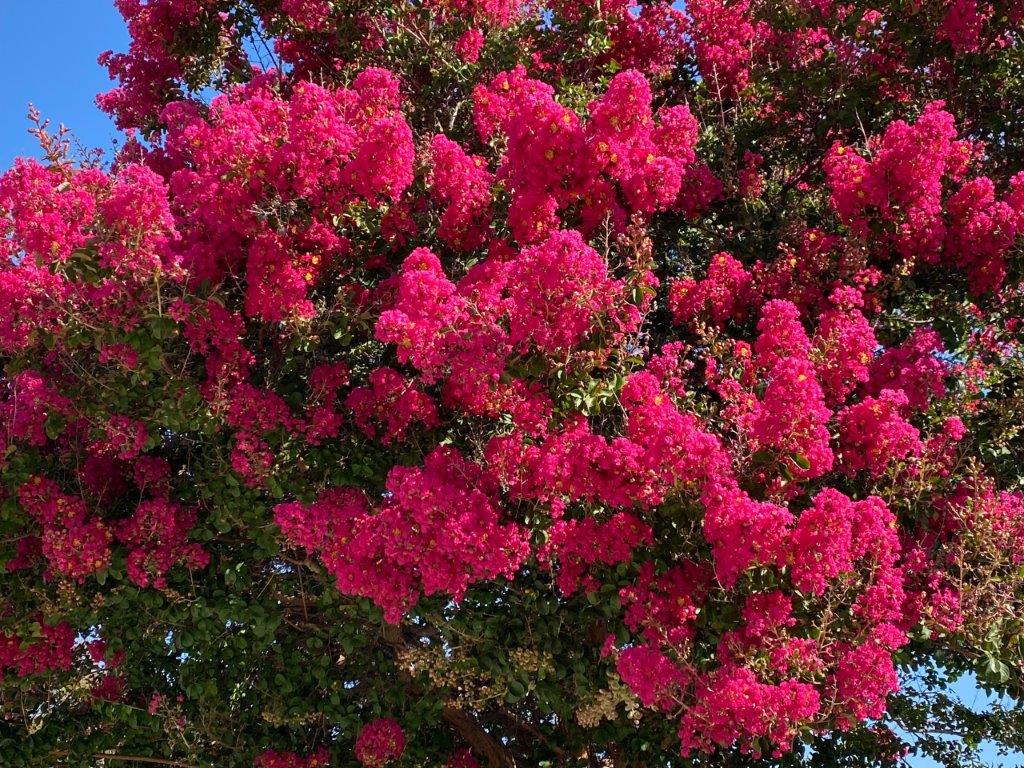
Article and photos by Emina Darakjy
July Tree of the Month
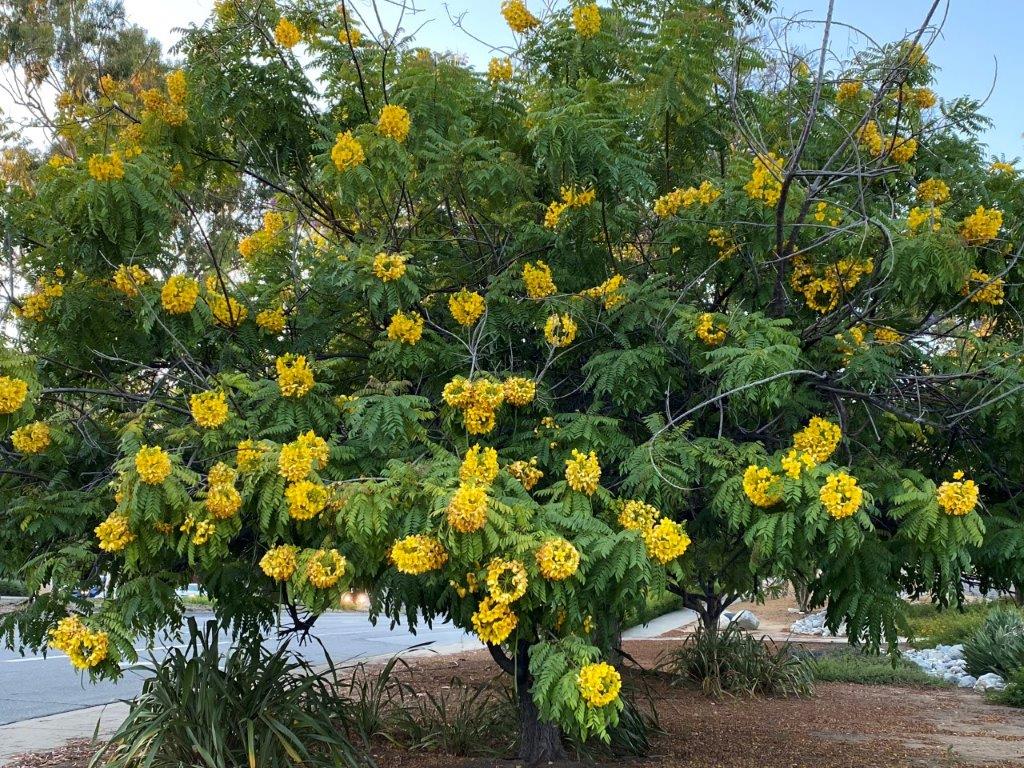
Cassia leptophylla – gold medallion tree
Family: Fabaceae
The gold medallion tree is native to the tropical forests of southern Brazil.
This is a small to medium size evergreen tree but can become deciduous when temperatures are in the 25-30°F range. The tree can reach a height of 20 to 30 feet with an open crown and a 25-30 feet wide spreading canopy. Its branches are droopy with dense dark green foliage consisting of pinnately divided leaves with 1-2” long leaflets making it a good shade tree. The trunk is gray-brown and furrowed.
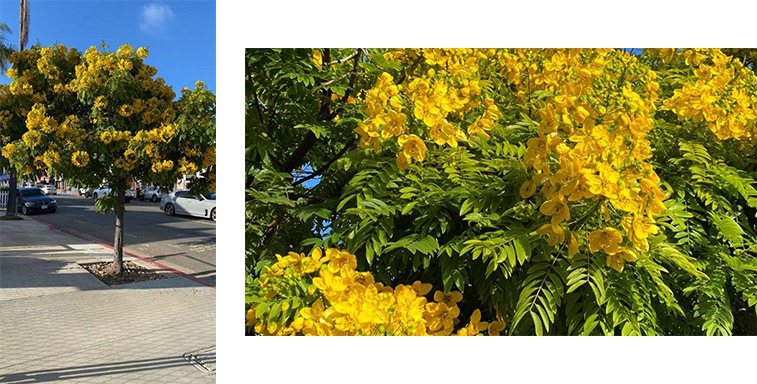
In the summer, this gorgeous looking tree is covered with clusters of very large flowers with each resembling a bouquet that tends to hang on the tree for a long time. The flowers are bright yellow, showy and fragrant. The bees and butterflies love them.
In the fall after the tree is finished flowering, long, thin bean-like seed pods up to 2 feet long dangle from the tree. The pods are green at first turning brown and woody later. The seeds are non-edible.
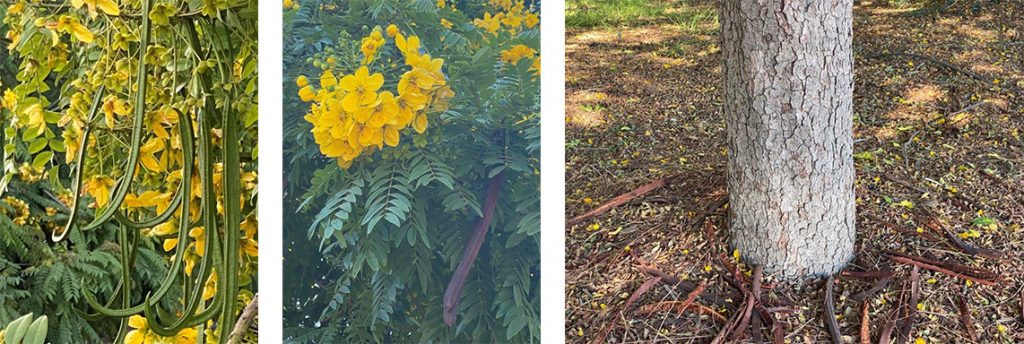
The tree does not require much maintenance but would benefit from a good pruning when young to help it develop a strong trunk and branches as well as for sidewalk clearance especially when planted as a street tree. The tree is considered drought tolerant and is fast growing. It does better in the sun and in a well-drained soil. At the present there are no known serious diseases affecting this tree and damage to sidewalks from this tree’s roots is very low.
This tree is a good candidate for residential landscaping, as a street tree, or in a park. We have the Los Angeles County Arboretum to thank for introducing it in 1958. I am noticing this tree everywhere I go now, and there is a good reason for that as when in bloom this spectacular looking tree brings a smile to everyone’s face and shouts “Hello Sunshine”.
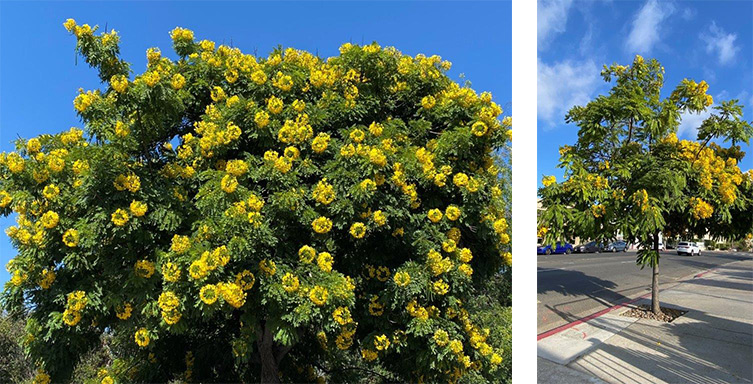
Article and photos by Emina Darakjy
June Tree of the Month
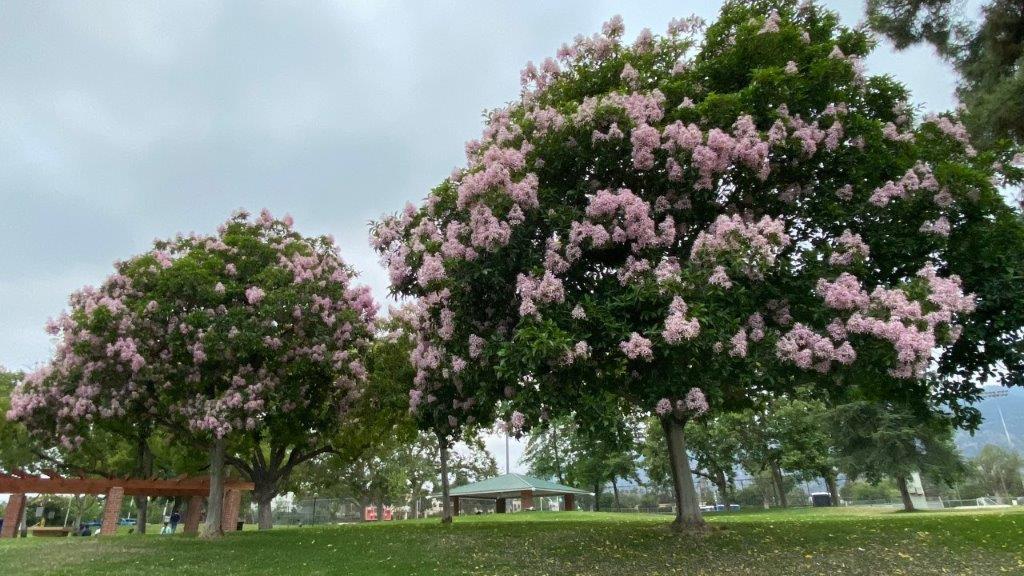
Calodendrum capense, Cape Chestnut
Native to the Cape region of South Africa and is a member of the Rutaceae family.
The Cape chestnut is a small to medium size slow growing tree with a dense rounded canopy and can reach a height of 20 to 40 feet tall and 25 to 40 feet wide. The tree is considered evergreen and it produces lots of shade but is prone to being briefly deciduous in colder weather.
The trunk is smooth, light to dark grey in color. The leaves are ovate, glossy dark green, simple not serrated, turning gold in the fall. When crushed the leaves release a lemon/pine scent.
In the late spring to early summer the crown and all its leaves get completely covered with clusters of delicate flowers each having five petals with thin filaments that protrude from the center of the flowers.
In the fall, and after all the blooms are gone, five-lobed capsules appear on the tree, they are green with a warty surface turning brown before opening like a flower exposing small black seeds. An oil known as Yangu oil is extracted from these seeds and is used in many skin and hair products throughout Africa.
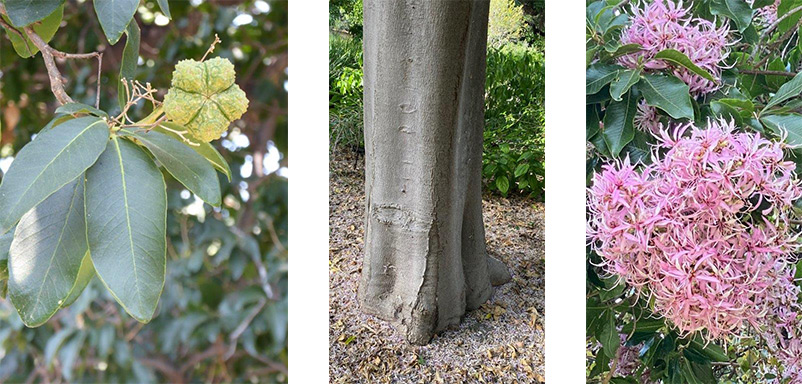
The tree does better in full sun, moist but well drained soil, and requires a moderate amount of water. The roots of this tree are non-aggressive making it a good candidate for a street tree. It also adds a spectacular focal point to any garden or a park.
Presently this tree is not prone to any pests or diseases that we know of.
In Greek the word Kalos means “beautiful” and the word dendron means a “tree” thus “Beautiful Tree”. The word capense means “from the cape” in Latin. In my opinion the Cape chestnut tree more than lives up to the meaning of its name!
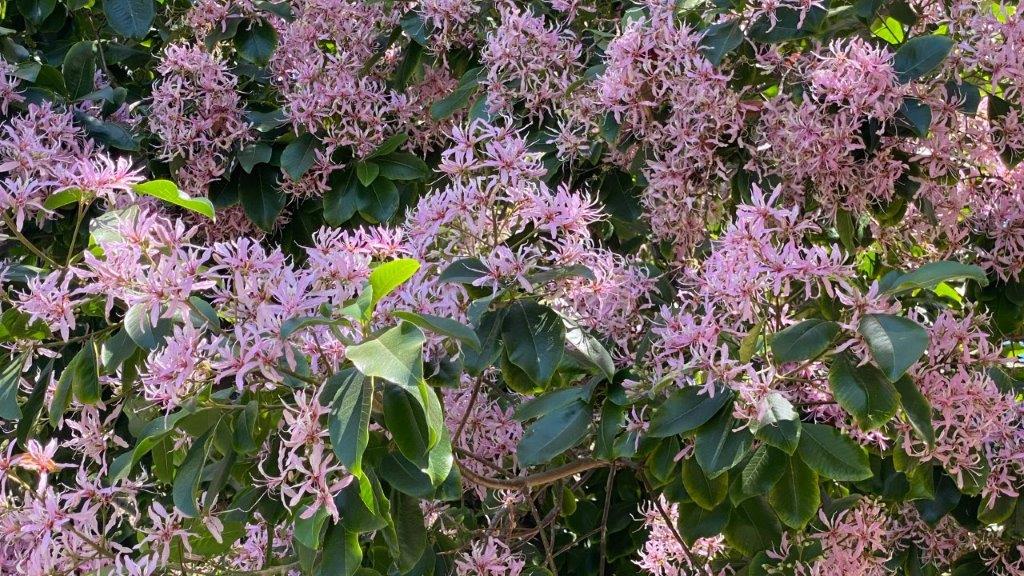
Article and photos by Emina Darakjy
May Tree of the Month
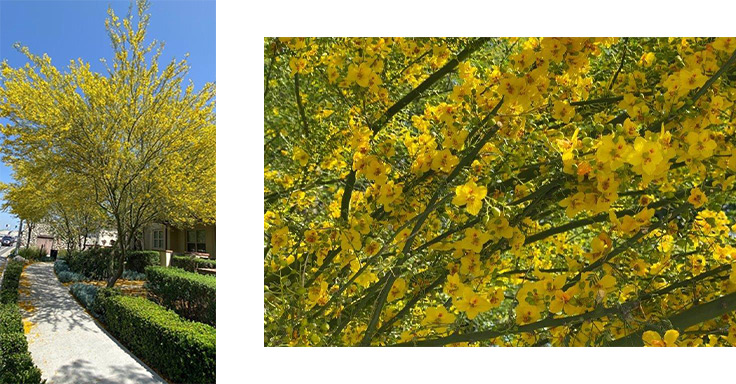
Parkinsonia florida – blue palo verde
Synonyms: Cercidium floridum
This tree belongs to the Fabaceae family and is native to southeastern California, central and southern Arizona where it is considered the official State tree and in northwestern Mexico where its name means “green stick” in Spanish.
The blue palo verde is a moderate to fast growing small to medium size deciduous tree, 20 to 30 feet tall and about 20 to 25 feet wide with a rounded canopy with arching branches. The leaves are light green, alternate and bipinnately compound.
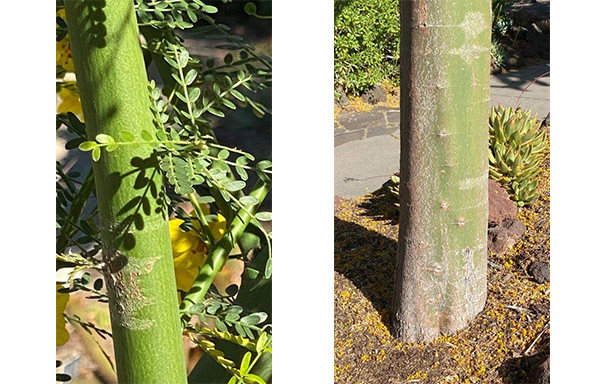
The trunk on young trees is chartreuse green turning grayish and scaly as the trees matures, the branches are green and smooth making the tree interesting to look at throughout the year even when it is leafless and not in bloom.
In late spring and into the summer with the leaves absent, the tree produces a spectacular display of bright yellow flowers with tiny red splotches in the center of them. The flowers are lightly scented. The fruit or pods as they are called appear in the fall, are light green, very small and contain seeds in them. The pods are a good source of food for birds and the flowers are a magnet for honey bees.
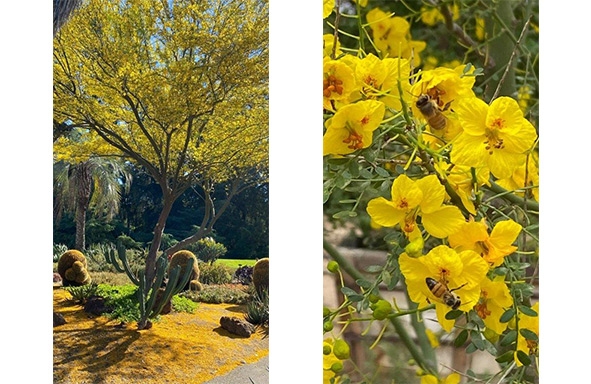
This is considered a very tough tree, does better in full sun but can tolerate some partial shade, is very drought tolerant and prefers a well-drained soil. The tree is very easy to grow and care for and if needed prune lightly in the summer. This tree is a good candidate for planting under the power lines and the damage to sidewalks from its roots is very low.
Pests to look out for are wood borers, spider mites and root rot. Having said that, if you keep your tree healthy and not over water it, you don’t need to worry too much as pests seem to attack stressed trees.
This is a gorgeous tree when in bloom, can be grown as a single or multi trunk form in parks, parking lots and adds a beautiful focal point to one’s garden complementing other drought tolerant plants.
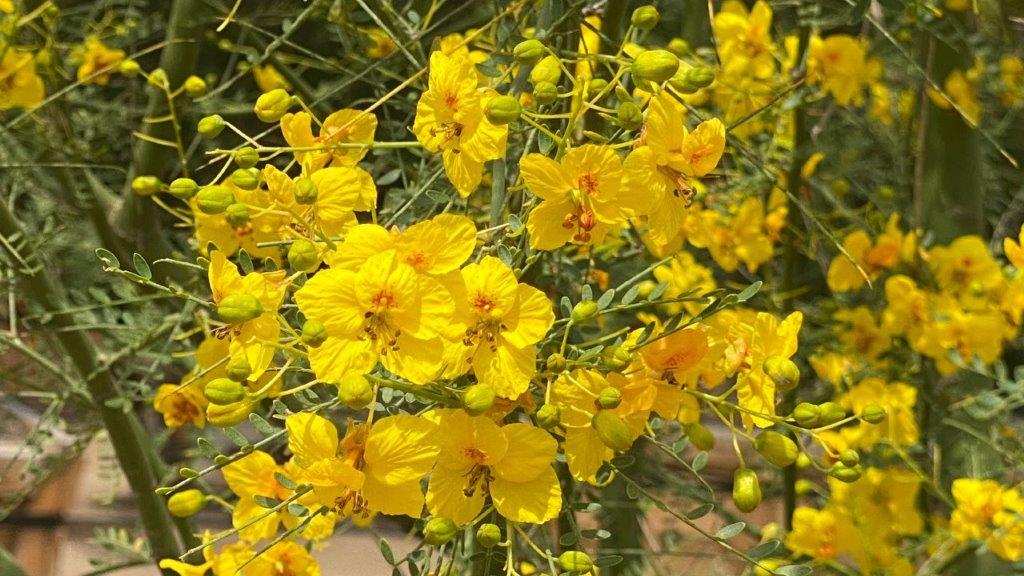
Article and photos by Emina Darakjy
April Tree of the Month
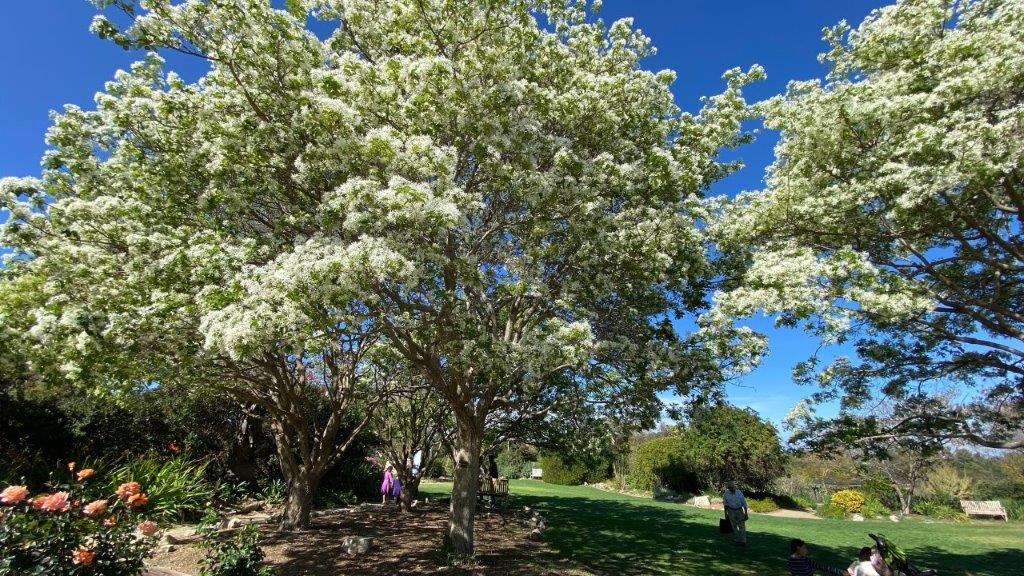
Chionanthus retusus – Chinese Fringe Tree
Family Oleaceae
The name is derived from the Greek words Chion and anthus meaning snow and flower.
Origin: Native to Eastern and Central China, Japan, Korea and Taiwan.
The Chinese fringe tree is a deciduous medium size flowering tree, grows between 20 to 25 feet tall and about 20 feet wide. The canopy is oval shape with dark green glossy leaves that turn to a golden yellow before they drop in the fall.
The bark is a grayish-brown color, scaly when the tree is young, becoming furrowed and showing a reddish color in the fissures as the tree matures.
The tree blooms from spring to early summer with the whole canopy covered with clusters of snow-white fragrant fringe-like flowers. These flowers are larger on the male variety. However, only female trees produce 1/2” to 3/4” size fruit that is dark purple and resembles grapes. The fruit is a good source of food for birds and the flowers attract many other types of pollinators.
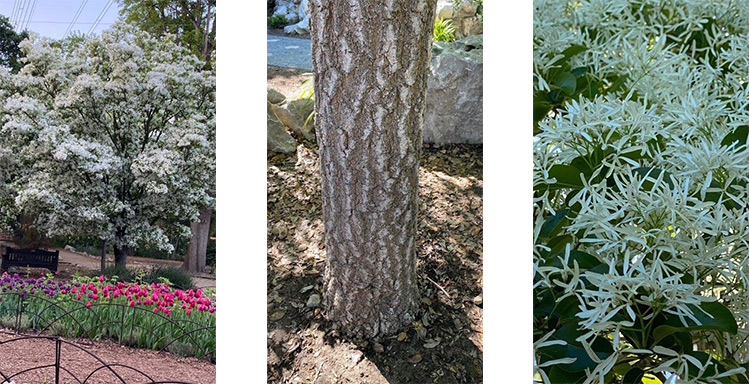
The tree is very easy to grow, does not require much care, adapts to many soil types, prefers sun but can tolerate partial shade and requires moderate watering. If you need to prune for shaping, do that after the tree is done flowering in order to allow the buds for next year’s blooming cycle to develop on the new branches. The tree is a good candidate for planting under power lines and in narrow parkways.

At the present there are no known serious diseases or pest problems. However, the tree can become susceptible to root problems if it is overwatered, and can also get infected with spider mites and scale both of which are easily controlled.
This tree is so spectacular when in bloom it makes for an excellent specimen in one’s garden either as a single or multi trunk form as well as in a park and even as a street tree as a single trunk form. In my opinion this gorgeous tree is underutilized and I would love to see us plant more of it.

Article and photos by Emina Darakjy
March Tree of the Month
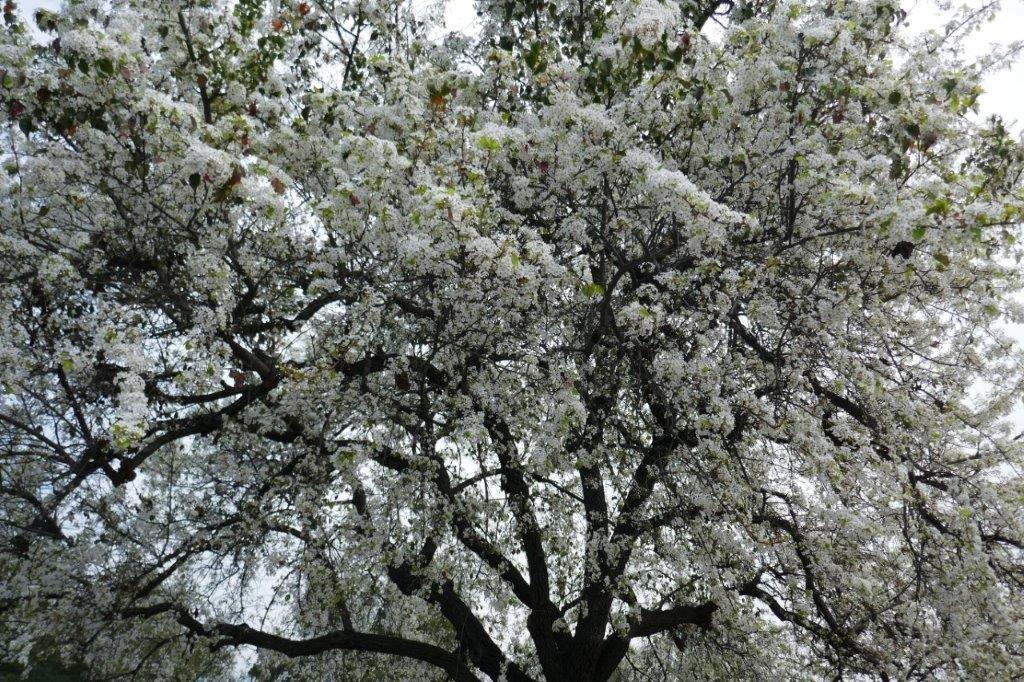
Evergreen Pear, Pyrus kawakamii
This tree belongs to Rosaceae family and is native to China and Taiwan. It is considered a small to medium size evergreen tree and grows up to 30 feet tall with a dense umbrella shaped canopy which provides a lot of shade. The trunk is a charcoal gray color exhibiting a deeply cracked darker bark with age.
The leaves are oval and start glossy green with serrated edges turning to a spectacular shade of yellow, orange and bright red before dropping to the ground in the fall. For this reason, some people might consider this tree semi-deciduous.
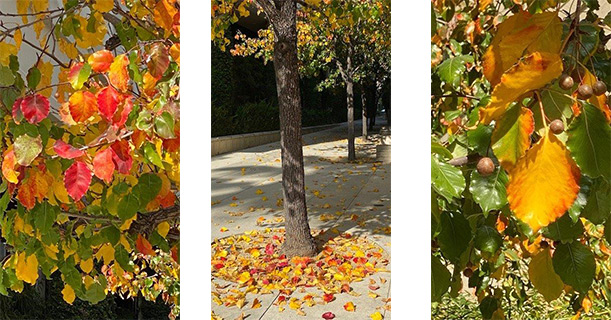
From January to March the tree is covered with masses of small dazzling white blossoms that attract many pollinators such as bees and birds that love to eat the round and very small fruit (as seen in one of the photos) that appears in the spring. With the slightest breeze the dainty blossom petals find themselves cascading to the ground like snowflakes. If necessary, prune lightly to shape the canopy. Over pruning results in fewer blooms. This is a good candidate for planting under power lines.
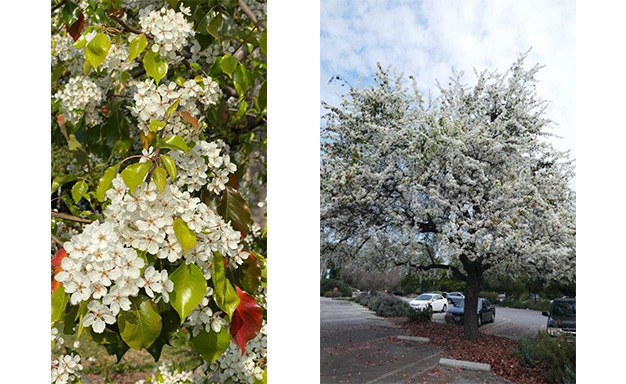
This tree performs better when planted in full sun and in a well-drained soil but can withstand partial-shade. When young, the tree requires moderate watering becoming more drought tolerant with age.
The evergreen pear is generally considered pest free but can be susceptible to aphids, fire blight and whiteflies which can easily be controlled with available treatments. So, don’t let this discourage you from planting it as its beauty outweighs the chance it might be affected with one of these problems.
Throughout the year this is a very stunning looking tree. It makes for a good street tree or in one’s garden. Besides planting a single trunk form you can also choose to grow it as an espalier along a wall.
Article and photos by Emina Darakjy
February Tree of the Month
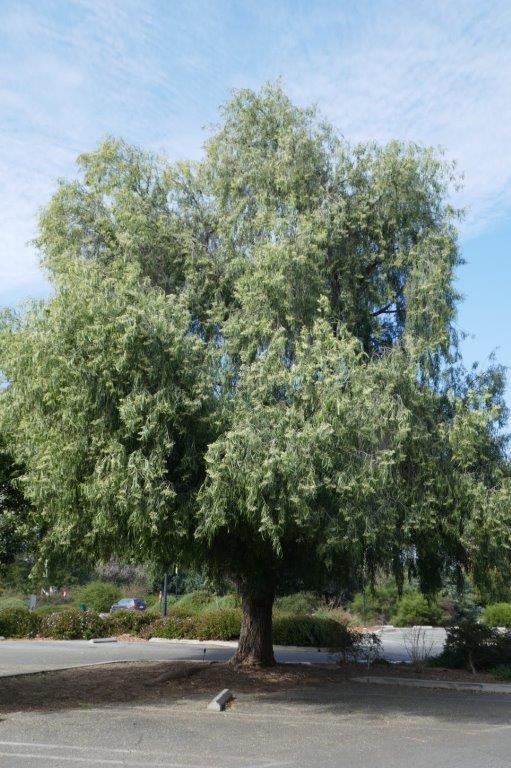
Australian Willow, Geijera parviflora
Family: Rutaceae
The Australian willow is native to the dry interior areas of eastern Australia. It is evergreen and considered a medium size tree with moderate growth reaching 30 to 35 feet tall and a spread of 20 to 30 feet wide. The canopy is dense, oval with a definite weeping form similar to that of a true willow.
The trunk/bark of the tree is smooth and light gray when young becoming dark gray furrowed as the tree matures. The leaves are olive-green color, slender, 4 to 6” long and droop down and are aromatic when crushed.
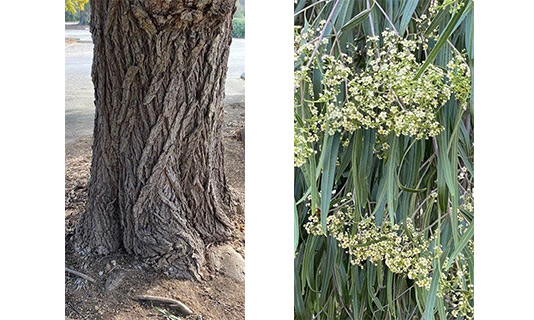
From November to late spring the tree is covered with clusters of fragrant creamy white flowers, with a scent similar to that of the citrus tree flowers. These small flowers are known to attract a wide range of birds and bees.
The Australian willow is a very hardy tree, tolerates many soil conditions, is considered drought tolerant and can grow both in the sun and partial shade. The tree roots grow deep down, are non-invasive and do not cause any sidewalk damage. The tree has no known pests or disease problems and requires very little maintenance. When young this tree can benefit from light pruning to help form a strong structure and some branch clearance when planted as a street tree.
The Australian willow is a beautiful shade tree and an excellent choice for parking lot islands, parks, as a street tree and in your garden. You can find several examples of this tree planted by Pasadena Beautiful Foundation, thriving at Victory Park to the left of the Paloma Street parking lot entrance.

Article and photos by Emina Darakjy
January Tree of the Month
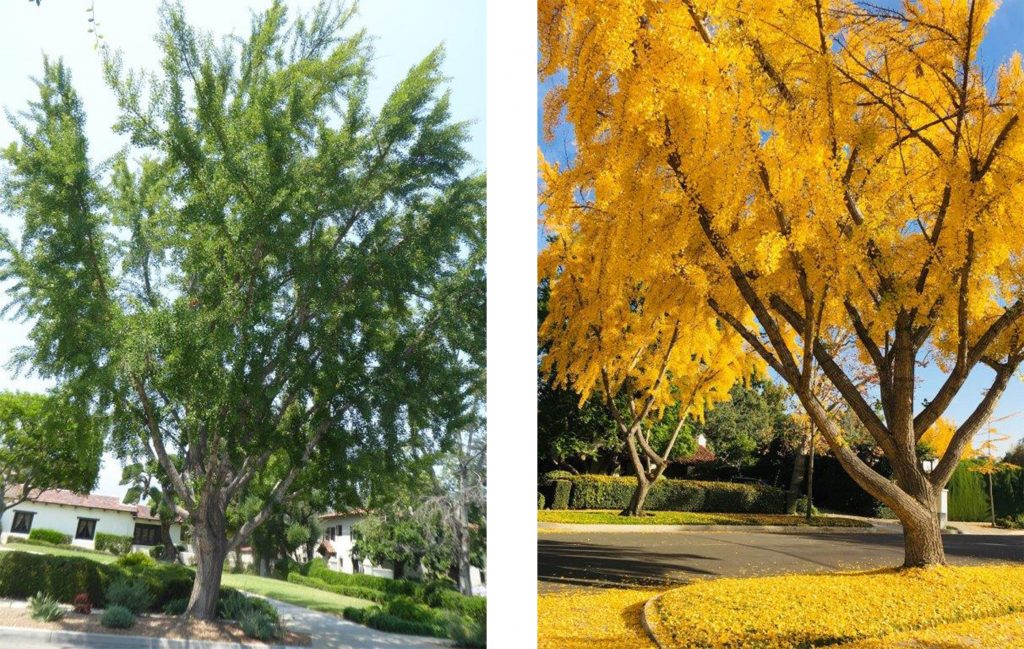
Ginkgo biloba – also called maidenhair tree
Family: Ginkgoaceae
Origin: Southeastern China
This is a tall deciduous tree, slow growing, it can reach a height of 50 to 80 feet and a spread from 25 to 40 feet. When the tree is young the trunk bark is light gray becoming darker with irregular furrows as the tree matures. The leaves are flat and fan shaped. They start bright green in the summer turning to yellow in the fall before dropping like brilliant golden snowflakes carpeting the ground underneath. It is a beautiful sight to see.
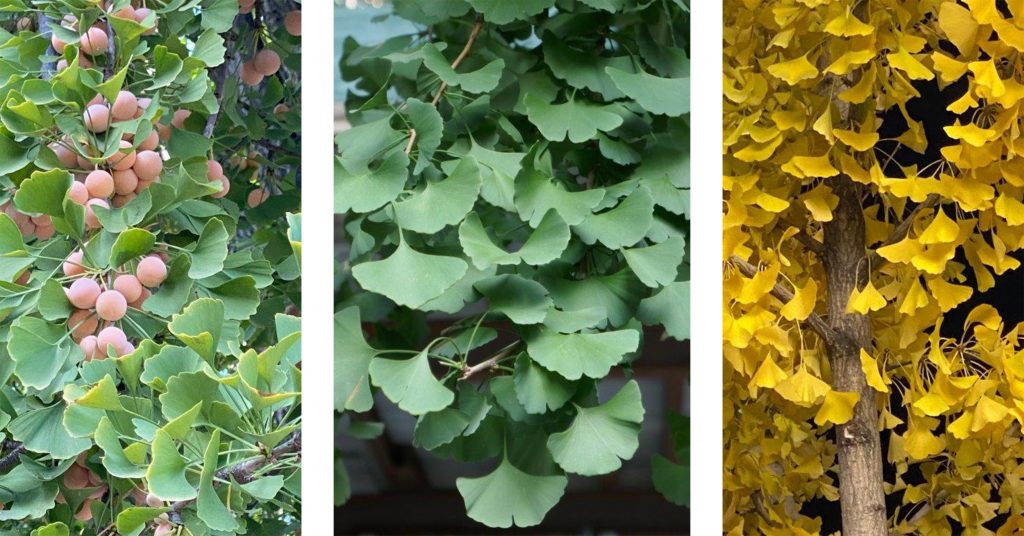
The ginkgo flowers are unnoticeable and fragrant. The female variety produces fruit that looks like small plums (as seen in one of the attached pictures) that drop when ripe and has a foul smell when crushed by people walking on it. It can also cause a slip hazard. To avoid this nuisance, make sure you plant only male grafted cultivars. The fruit is however considered a delicacy in the Orient where the inside seed is roasted before it is consumed.
The Ginkgo adapts to any soil conditions, withstands air pollution, is drought tolerant, grows in partial shade but does better in full sun and is not recommended underneath power lines.
The Ginkgo can be found as a street tree in medians and in parks. When given ample room to grow the tree exhibits wide spreading branches. If space is tight, try and plant something called “Fairmont” which grows in a conical form or the “Princeton Sentry” which has an even narrower column-like shape.
The Ginkgo does not require a lot of maintenance. It can benefit from some light spring pruning when young but hardly needs any when mature. It does not have any significant known pest problems and is resistant to oak root fungus. It is worthy to note that the Ginkgo is considered as one of the oldest living trees. Research and fossil records show that the Ginkgo existed during the Jurassic period millions of years ago.
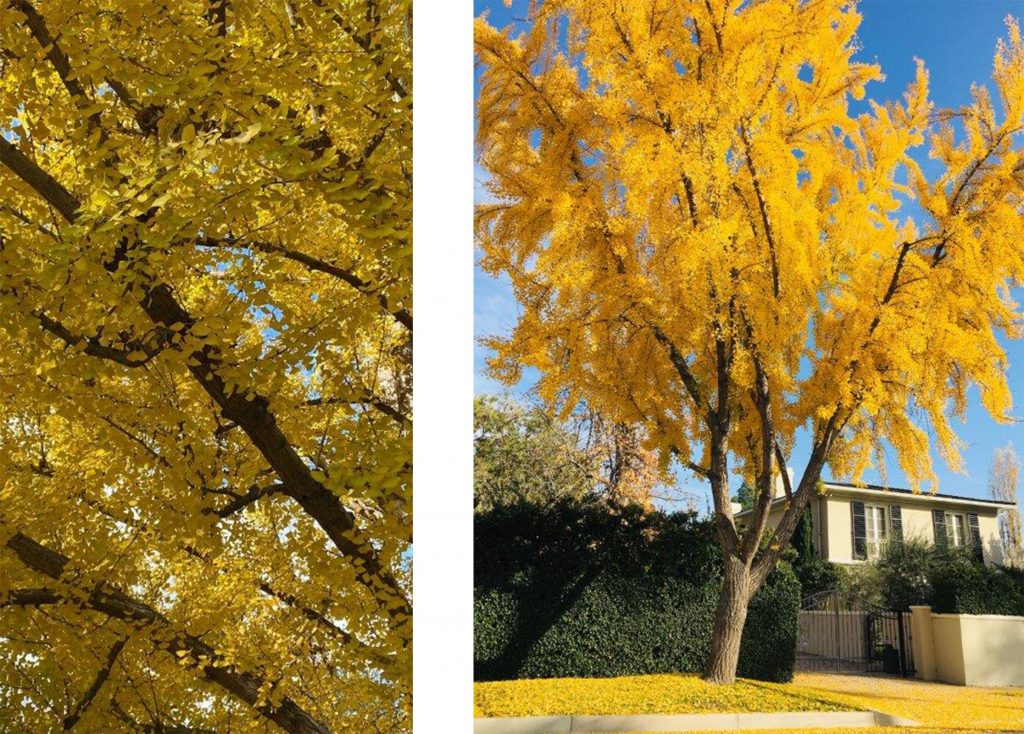
Article and photos by Emina Darakjy
December Tree of the Month
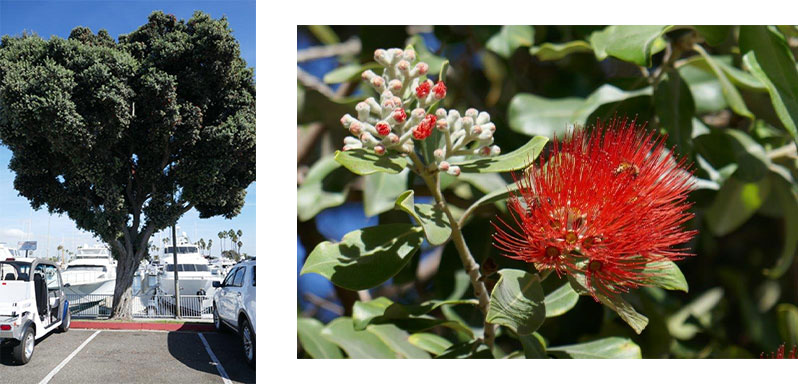
Metrosideros excelsa, New Zealand Christmas Tree
Family: Myrtaceae (Myrtle)
Origin: Coastal New Zealand and Australia
The Metrosideros excelsa is an evergreen tree with a rounded dense crown reaching a height of 35 feet with an equal spread. The tree can be grown as a multi-trunk or single trunk, does well in full sun but can tolerate light shade.
In New Zealand this tree is called Pohutukawa, and blooms during their summer months which are November to January with a peak blooming cycle around Christmas time thus its common name.
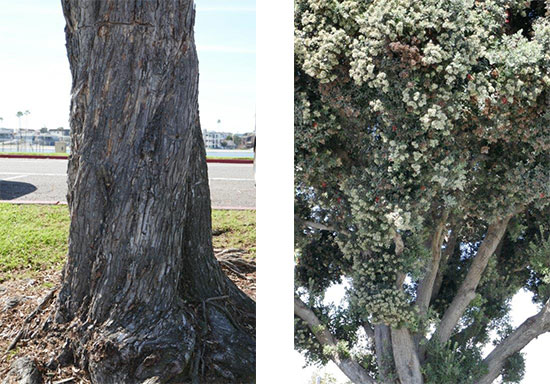
The trunk starts smooth becoming rough and fissured with a grayish-brown bark. The leaves are oval and have a beautiful glossy shade of gray/green.
Flowers start as white buds before opening to a very showy crimson red with thin long stamens resembling the flowers of a bottlebrush tree attracting birds and bees.
This tree is smog and drought tolerant, adapts to any soil conditions, tolerates the salty coastal mist making it a good candidate for coastal plantings. The tree is considered pest free but can be susceptible to Phytophthora and Root Rot. It’s aggressive roots can cause sidewalk damage. Another noticeable feature of this tree is its aerial roots which hang down from its branches. If left alone, they can touch the ground and take root forming extra trunks.
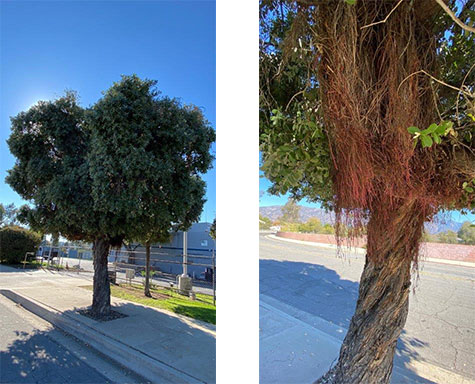
This is a beautiful tree especially when in bloom, makes a great accent in a garden, median or as a street tree, and is safe to plant in areas where deer are present. It is also on Southern California Edison’s list of recommended trees to plant under powerlines..
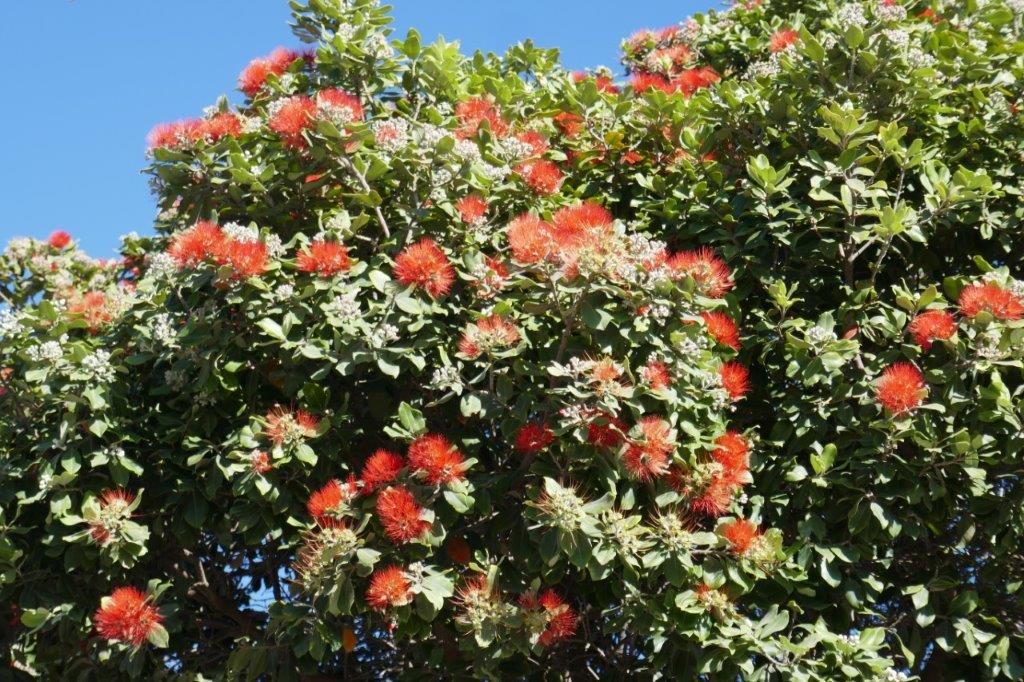
Article and photos by Emina Darakjy
November Tree of the Month
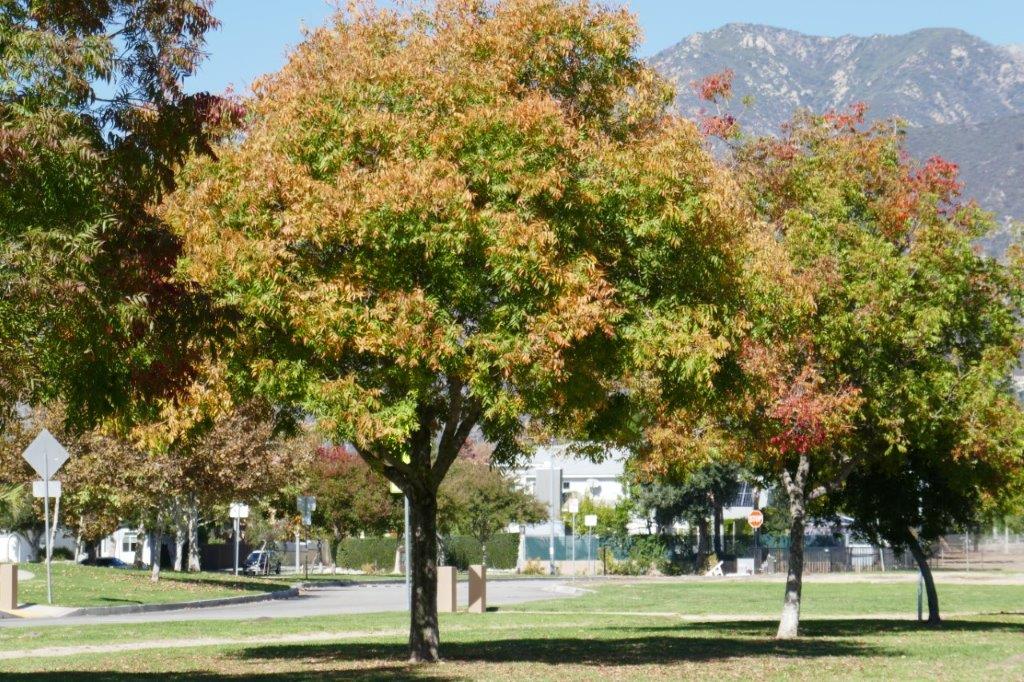
Pistachia chinensis, Chinese pistache
Family: Anacardiaceae
Origin: Native to China, Taiwan and the Philippines
The Chinese pistache is a good shade tree with a rounded crown, fast growing when young and can reach a height of 40 to 50 feet tall with an equal spread. The tree is briefly deciduous. When young this tree can benefit from pruning during the winter but rarely requires any pruning when mature.
The trunk or bark is grayish-brown, smooth at first, becoming fissured as the tree matures. The leaves are alternate, pinnately compound, green at first before turning into a mix of a fiery shade of red, orange and bright yellow producing a stunning display of fall color. The leaves are aromatic when crushed.
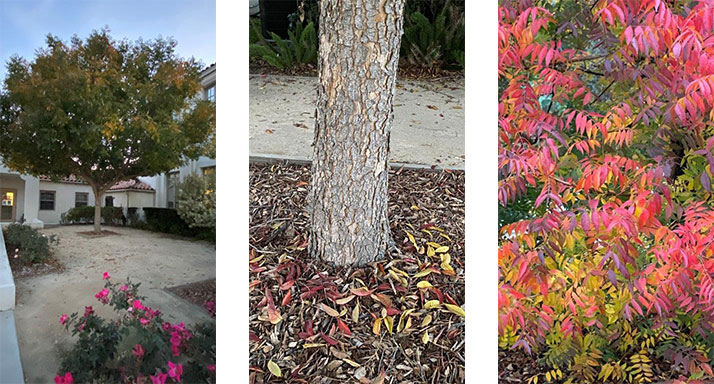
It is related to the pistachio tree but does not produce any nuts, instead the female Pistachia chinensis produces clusters of small round vivid red fruit turning to blue and purple in the fall. The fruit can be a nuisance creating a slip hazard when they fall on the ground. The fruit attracts many bird species especially parrots who go crazy over them. If this is a concern, consider planting a fruitless grafted male variety instead. You can then enjoy the spectacular explosion of fall color whether the tree is male or female.
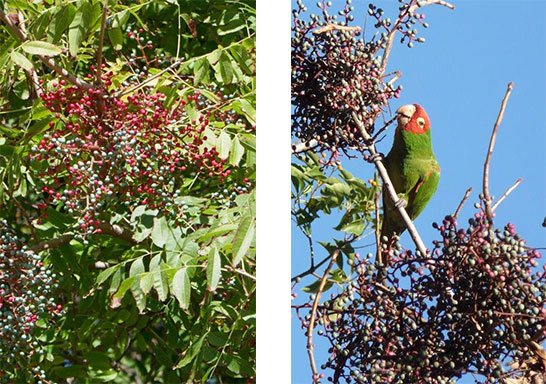
This tree tolerates almost any type of soil from alkaline to acidic, does better in a sunny location, is drought tolerant and can be planted in narrow parkways as a street tree, in parks, or as an accent tree in one’s garden. The tree is relatively pest free but is susceptible to verticillium wilt and root disease.
You can find this tree growing in Vina Vieja Park, in the 2800 block of East Colorado Boulevard and on Glen Avenue in Pasadena.
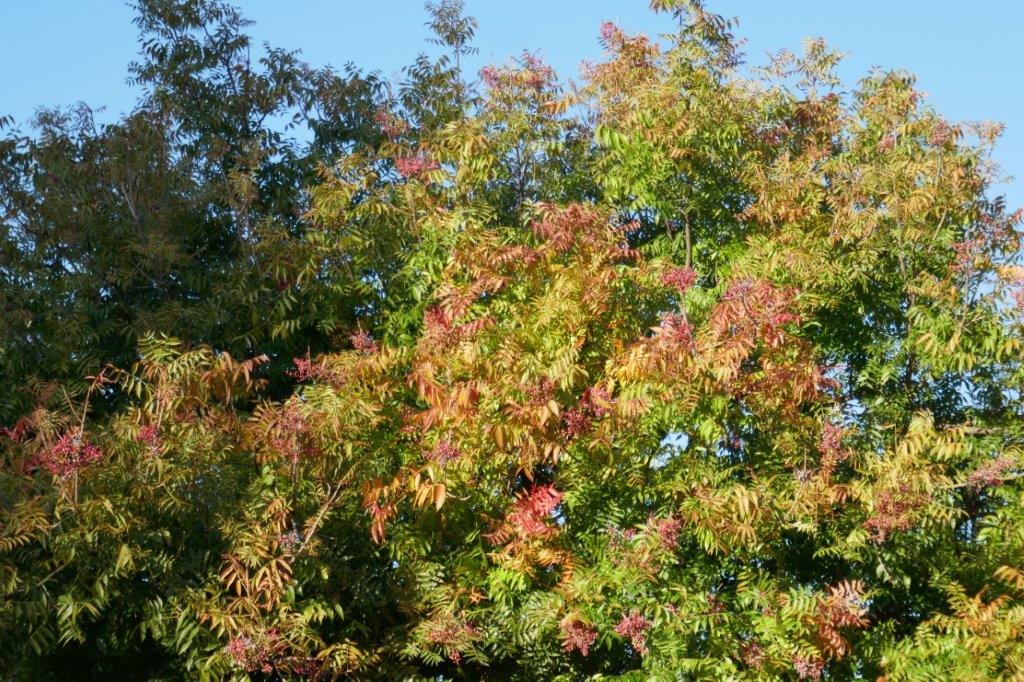
Article and photos by Emina Darakjy
October Tree of the Month
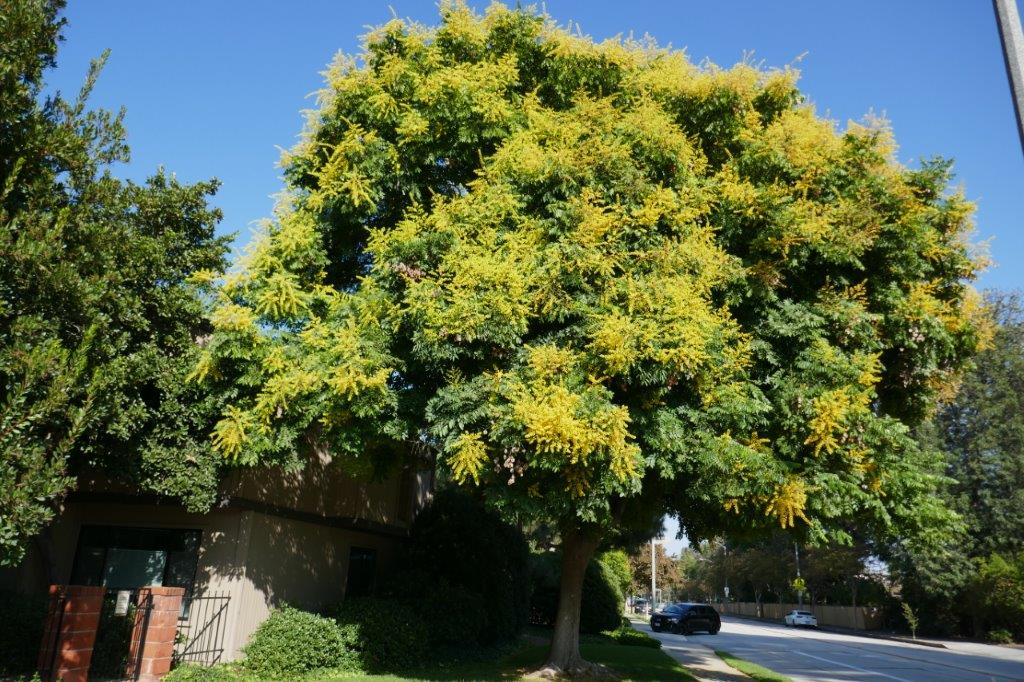
Koelreuteria bipinnata – Chinese Flame Tree
Family: Sapindaceae
Origin: Western and Southern China
This is an attractive medium size tree, fast growing with a rounded crown, that can live to 100-years old, and grows between 30 and 40 feet tall, and equally as wide. Its single trunk is grayish brown with furrowed bark.
The tree is deciduous. The leaves are alternate, bipinnately compound with toothed margins: they start green, then change to a golden yellow in the fall before they drop in late fall or early winter.

In late summer the tree is completely covered with clusters of fragrant yellow flowers that attract bees and last through the fall. The flowers are prolific. When they drop on the ground, they cover the sidewalk with a dazzling golden carpet. Fruit pods that resemble Chinese lanterns follow. They start light green, then they change to a salmon/red color in the autumn before becoming a papery shade of brown in the winter. They are used in floral arrangements. This is one of the few trees that blooms in the summer.
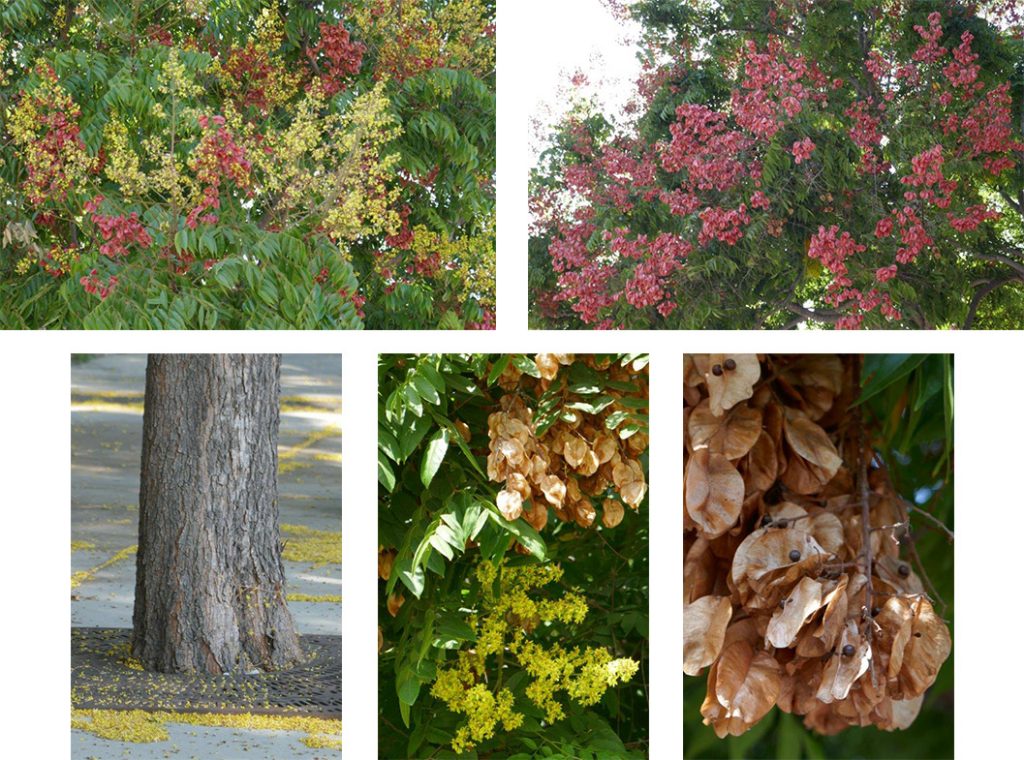
The tree is planted in parks for its shade during the summer months and does well in an urban setting as a street tree. Its roots are non-invasive. This tree grows best in full sun and tolerates the summer heat and air pollution. Water needs are moderate. It requires light pruning when young, but not much when mature. The tree requires 6 feet cutouts. Known pests are wood borers, scale and Verticilium wilt.
You can find this tree growing on Washington Boulevard between Hill Street and Allen Street as well as on Walnut Street in Pasadena.
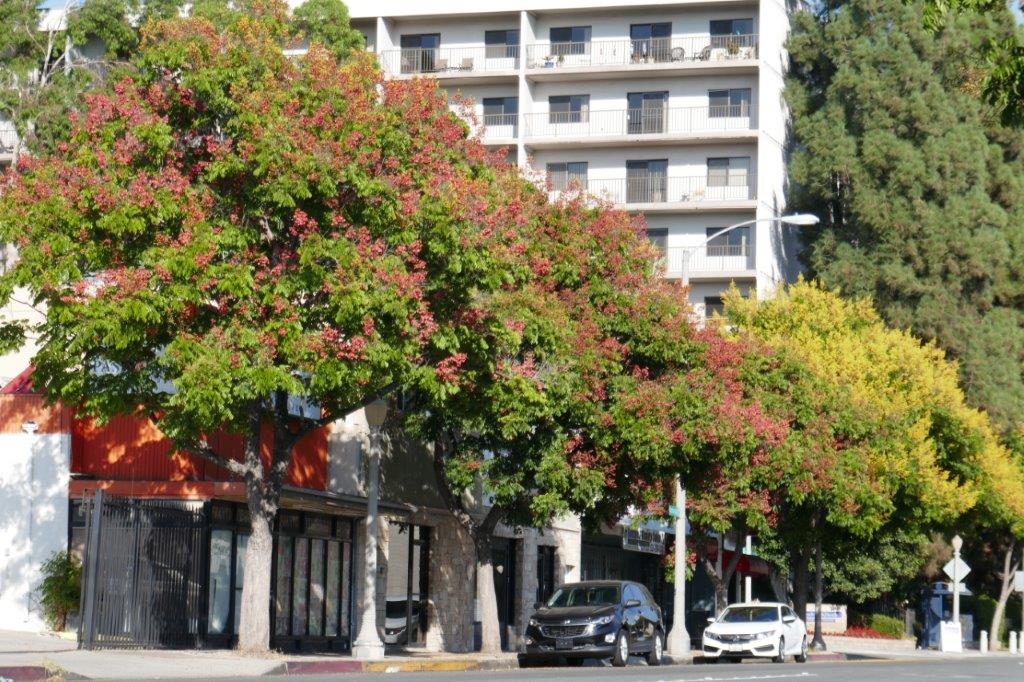
Article and photos by Emina Darakjy
September Tree of the Month
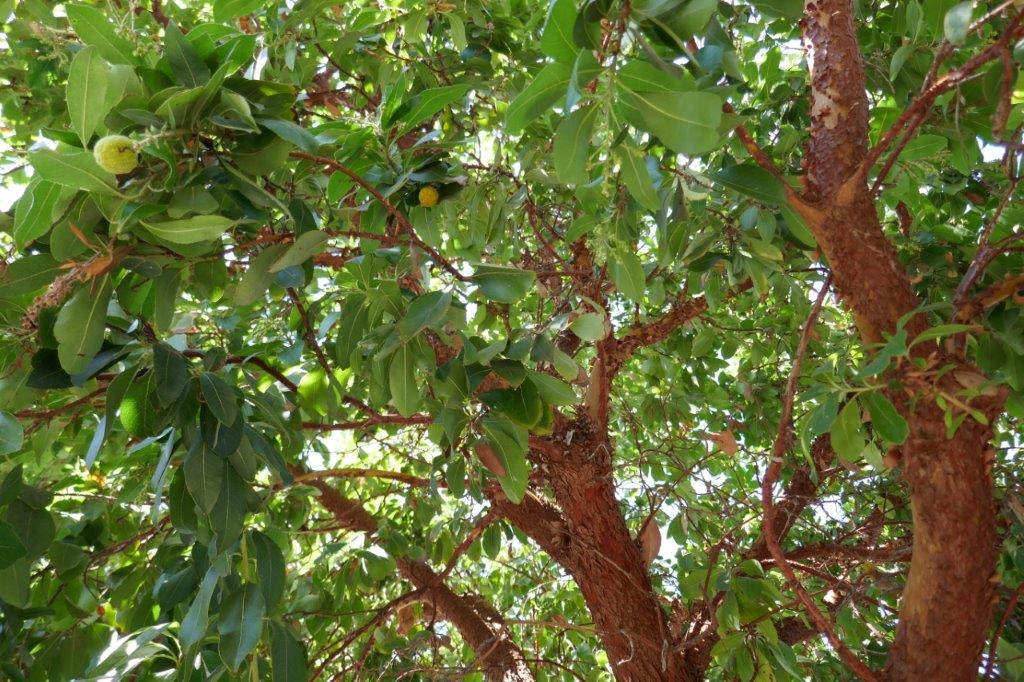
Arbutus ‘Marina’ – Strawberry Tree
Family: Ericaceae
Origin: A hybrid that was introduced to the Nursery Trade in 1984 by the Saratoga Horticultural Foundation.
The Arbutus ‘Marina’ is a very handsome evergreen tree with a broad canopy and dense foliage, native to the Mediterranean and some parts of Ireland. The growth rate is moderate, the tree can reach a height of 50 feet with a width of about 40 feet. The leaves are elliptic in shape, dark green, glossy with serrated edges. The tree has an amazing looking trunk with a reddish to cinnamon colored bark that peals away in layers in late summer exposing a smooth lighter colored bark underneath.
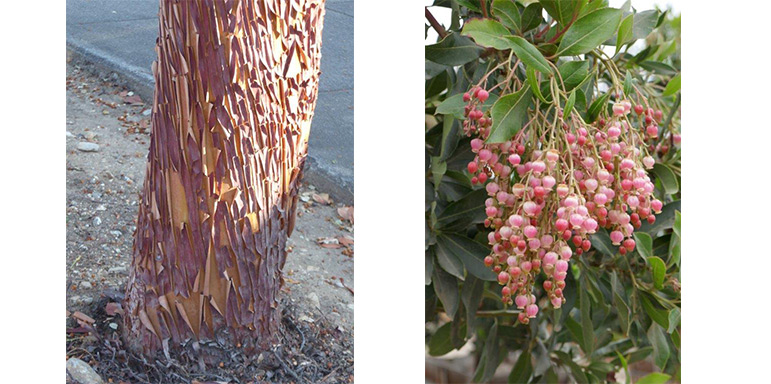
The flowers hang down in clusters (resembling the Lily of the Valley) in various shades of pink and attract bees, hummingbirds and butterflies. The tree tends to have both the flowers and mature fruit on it at the same time. The fruit can take up to 2 years to mature and looks like small rounded warty globes. They start green in color, turning yellow, orange and finally bright red at which point it becomes edible without much of a flavor though.
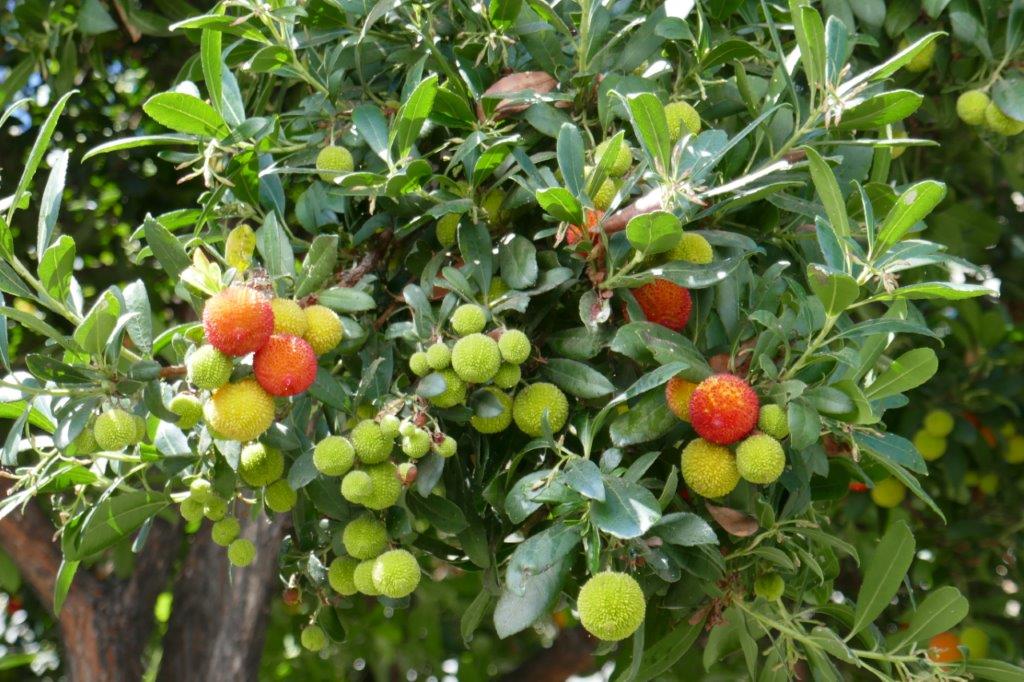
The tree does well in a 3-foot parkway, is drought tolerant once established, performs better in full sun, and can benefit from occasional pruning to shape it. It is not recommended for underneath power lines. The tree is resistant to Armillaria but susceptible to Anthractose, Scales and Thrips. The tree can be planted both as a standard or multi trunk form, this is a truly gorgeous tree but not very suitable as a street tree because the dropping of the ripe fruit on sidewalks is messy and slippery.
The tree in the photo can be seen where Thurgood Marshall and North Euclid streets meet behind the Pasadena City Hall.
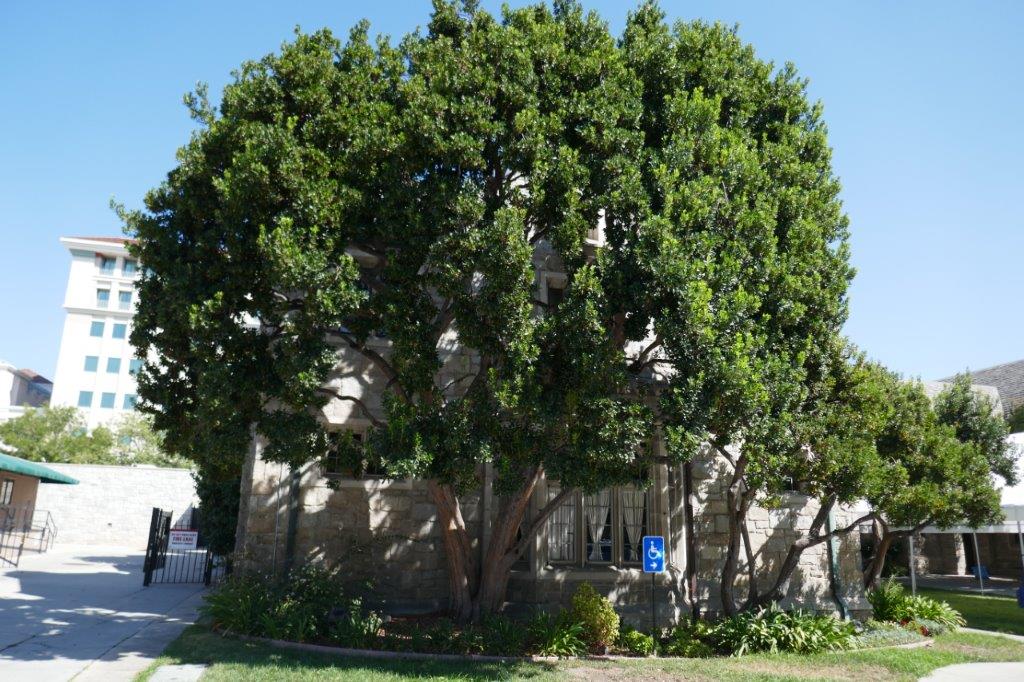
Article and photos by Emina Darakjy
July/August Tree of the Month

Jacaranda mimosifolia, commonly known as Jacaranda
Family: Bignoniaceae
Origin: Brazil and Argentina
The jacaranda is a very spectacular tree when in bloom. It is fast growing with a height of 25 to 50 feet, and a spread of 50 plus feet. It is considered a partially deciduous tree.
The leaves are light green and up to 2 feet long and each leaf is composed of dozens of ¼ inch leaflets. The leaves are delicate and fernlike. The trunk bark is grayish brown, smooth at first turning rough as the tree matures. In late spring the jacaranda tree gets covered with clusters of fragrant rich violet/blue trumpet shaped flowers that are 2 inches long. The tree continues to bloom sporadically throughout the summer. After that brown disk-shaped seed pods appear.
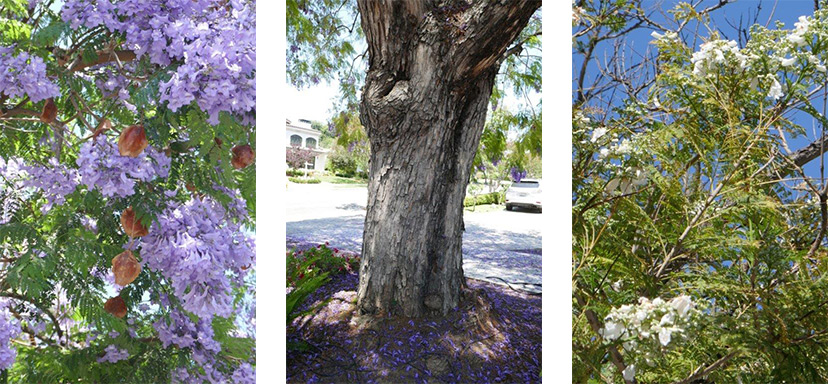
There is also a white flower variety which is rare called: Jacaranda mimosifolia alba. You can find one growing at the corner of south Lake Avenue and Del Mar in Pasadena.
The Jacaranda prefers a soil with good drainage, is drought tolerant when mature, does better in a sunny area but tolerates partial shade. It requires a minimum parkway width of 5 feet. The damage to sidewalks from its roots is moderate. The tree is susceptible to aphids and Phytophthora root disease.
In his 1988 book titled “Exceptional Trees of Los Angeles” Donald R. Hodel describes a Jacaranda tree at 1870 south Los Robles in San Marino as “The largest and most outstanding specimen in the area” with a 50 feet height and a spread of over 50 feet.
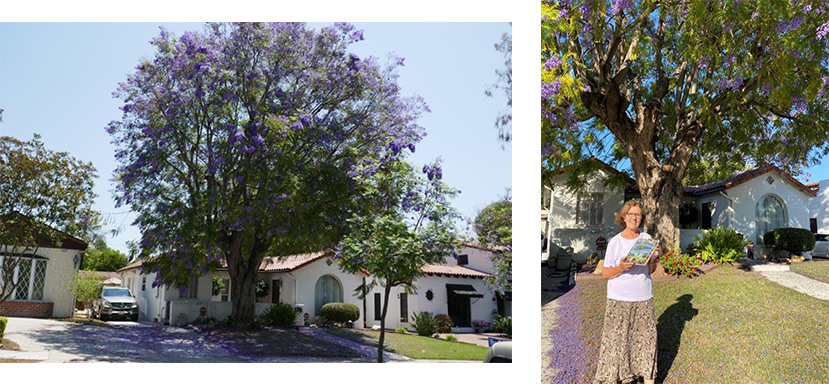
I visited this tree recently with Mr. Hodel’s book in hand and found the tree to be even more spectacular than it did in 1988. The homeowner came out and was very happy to see her tree featured in a book. She moved into the house 13 years ago and heard from her realtor that the tree is famous!
You will find the jacaranda trees gracing many neighborhoods and parks in southern California, and if your plane happens to be landing at LAX in late spring, don’t forget to look out of your window, you will be rewarded with a breathtaking view of a sea of purple flowers.
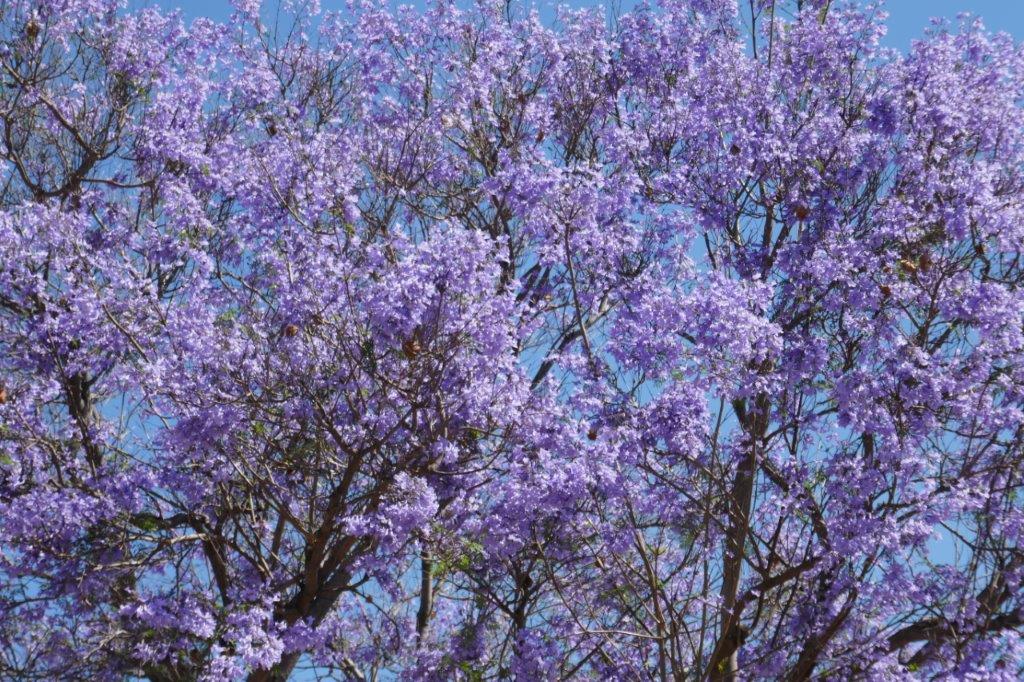
Article and photos by Emina Darakjy
June Tree of the Month

Quercus agrifolia (commonly known as coast live oak)
Quercus agrifolia also commonly known as the coast live oak which belongs to the Fagaceae (Beech) family is native to the California coastal mountains and valleys and can be found in areas from Mendocino County to northern Baja California.
This oak species is widely planted and in Pasadena it makes up for 10.08 % of the city’s tree inventory. This is a big evergreen tree which can reach a height of up to 70 feet tall. It has a large spread with gnarled branches and limbs with a rounded dense canopy. The trunk is short and therefore, does not make for a good timber tree. The tree is considered very drought tolerant and can withstand both the heat and coastal conditions. Like all other mature native California oaks, the coast live oak does not need to be watered during the summer months. Too much water can cause root fungus (Armillaria) which kills the tree. If planted in an irrigated area, make sure to direct the water spray away from the tree trunk.
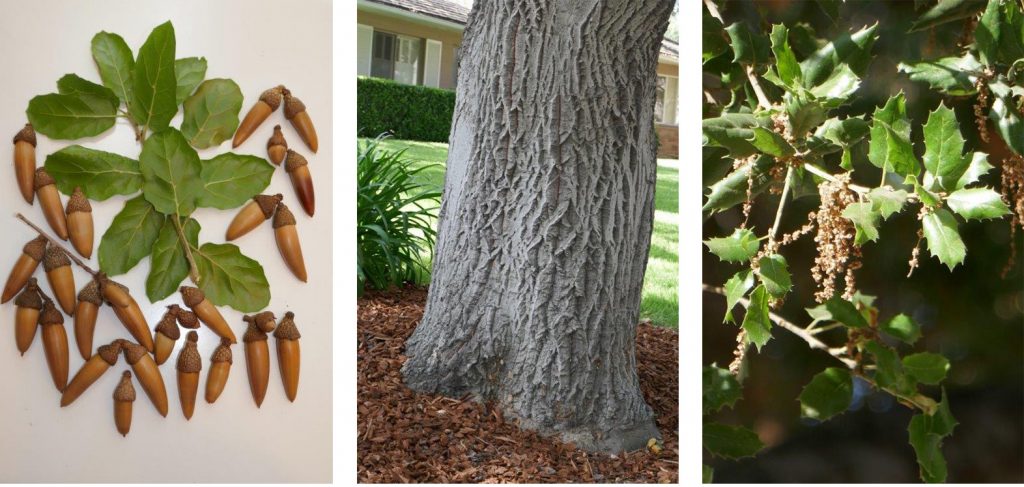
When young, the trunk and bark of the tree are smooth and light gray becoming dark brown and thick with deep furrows as the tree matures. The leaves are oval and curved under. It is spiny along the edges like the holly leaves, glossy dark green on the upper side and veins with tufts of hair on the underside. The acorns of the coast live oaks are narrow and pointed with a dark chestnut brown color and deep puffy caps. In the early days, these acorns provided a good source of food for Native Americans.
The coast live oak is a very attractive specimen tree and does well in urban setting when planted in a parkway that is at least 10 feet wide giving it ample space to grow. The tree does not tolerate severe root pruning and can cause moderate to severe sidewalk damage. Among some of the pests and diseases to watch out for are Armillaria (root fungus), oak twig girdler, sudden oak death, the California oak worm and the Polyphagus Shot hole borer.

Here is an important fact about the oak that many of you may not know:
In 2001 the National Arbor Day Foundation conducted a poll over a 4-month period asking people all over the US which was their favorite tree. At the end when the votes were tallied, the winner with 101,000 votes was the Oak (no particular species). Coming in second place was the California Redwood with 81,000 votes. Fast forward to 2004, Congress passed a historic bill which was signed on December 15th by then President George W. Bush making the oak America’s National Tree.
Article and photos by Emina Darakjy
May Tree of the Month
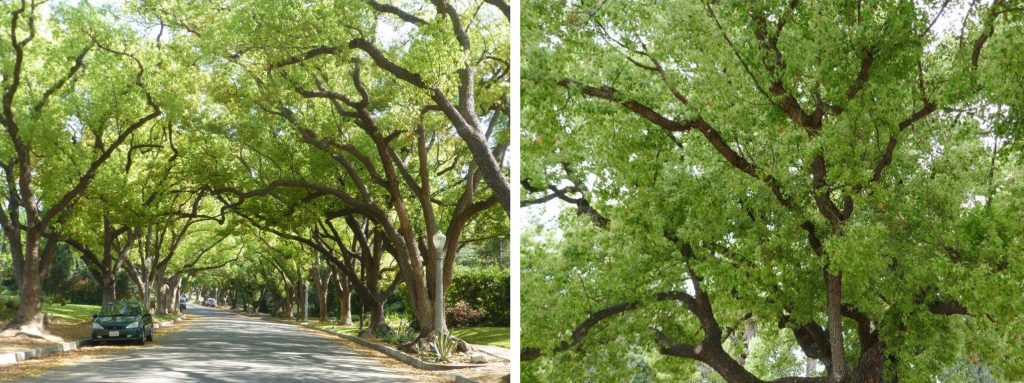
Cinnamomum Camphora (commonly known as camphor tree)
Synonyms: Camphora officinalis, C. officinarum
Family: Laurel
Origin: China, Taiwan, southern Japan, Korea and Vietnam
The camphor is a gorgeous evergreen large shade tree, grows moderately fast, its canopy is rounded, very dense with arching strong branches. The tree can grow up to 50 feet tall and more and twice that wide which results in overcanopying in several streets throughout Pasadena.
One such street where you get to drive through a tunnel-like-effect of greenery is Prospect Boulevard from Orange Grove to Prospect Terrace in Pasadena where the first camphor trees were planted in 1904 and several of them still grace the neighborhood. An interesting example is the black and white photo below taken in 1904, courtesy of the Pasadena Museum of History and a recent color photo of the same location showing the overcanopying.
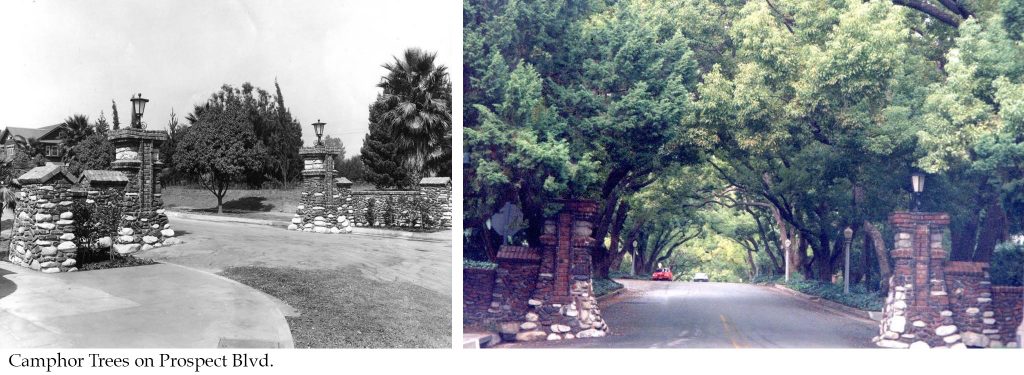
The camphor tree requires a large space to grow, does better in an 8- to 10-foot parkway, tolerates the summer heat and most soil conditions from acid to alkaline, it makes a great street tree, and does well in parks and large medians. The camphor tree is very prevalent in southern California and other southern states, it is however considered invasive in Florida. In Pasadena it makes up 9.17% of the city’s tree inventory list.
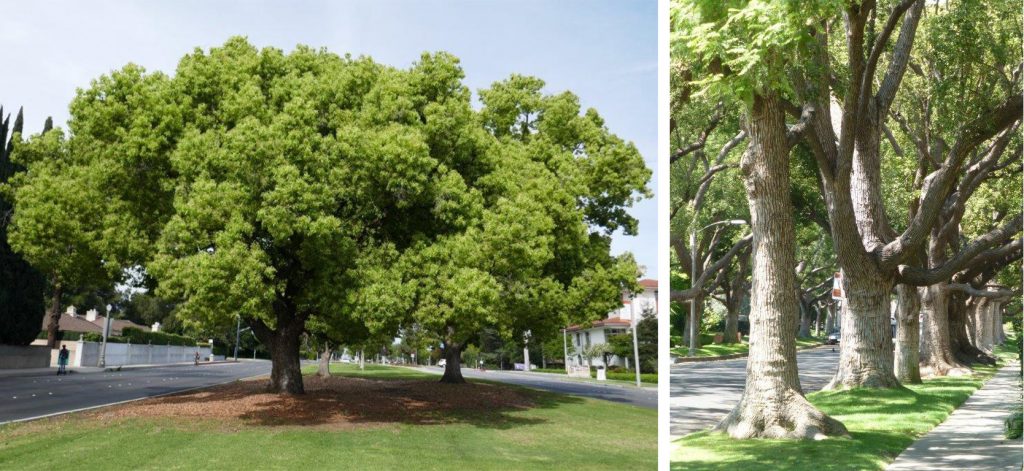
The trunk has furrowed light gray bark and becomes enlarged at the base with age. This unfortunately can cause the sidewalks to lift. The leaves are elliptical to ovate and emit a pleasant aroma of camphor when crushed. Even though the tree is considered evergreen some of the older leaves tend to drop in the late winter and early spring and are replaced with new pink to copper colored leaves that turn bright green and glossy as they mature.
In the spring the tree is covered with tiny little white to creamy, green-colored flowers that are fragrant, followed by clusters of globular black berries which contains a seed inside that birds love to eat.
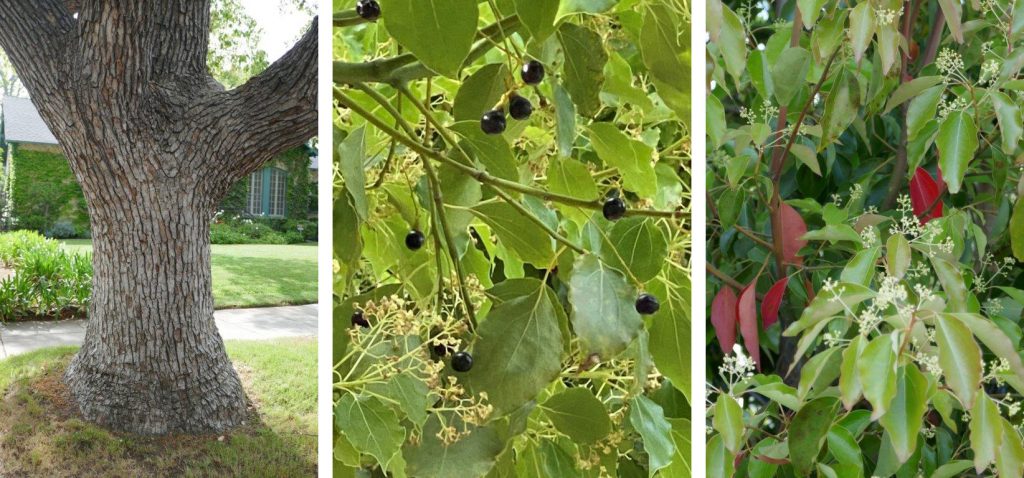
Some of the diseases to worry about are Verticillium wilt, root diseases and anthracnose. The tree is valuable commercially for the camphor that is distilled from its leaves and wood.
Article and photos by Emina Darakjy
April Tree of the Month
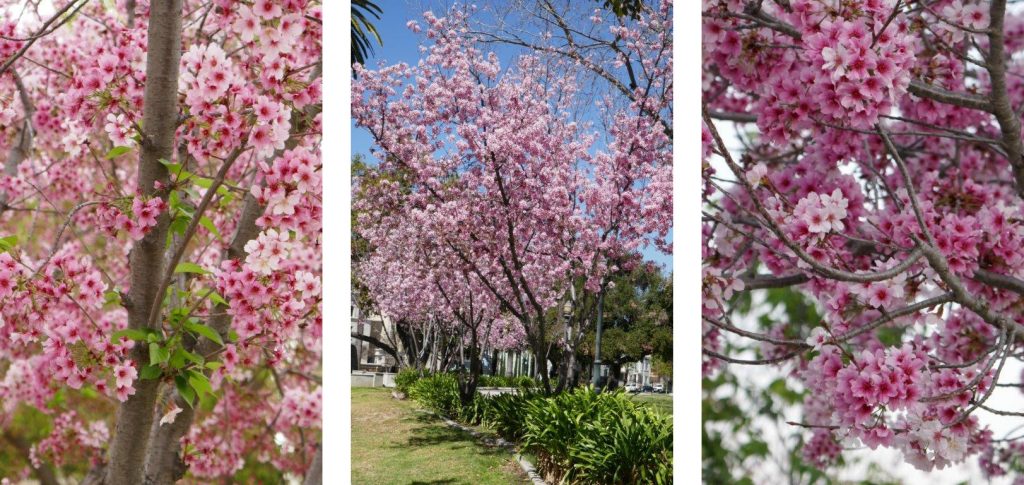
Pink Cloud Cherry Blossom Tree
Pasadena is very fortunate to have several Pink Cloud flowering cherry trees with dark pink flowers growing in Victory Park, Memorial Park and Central Park. These trees can also add a beautiful accent to any garden.
Some background information on how the cherry trees came to be planted in Pasadena. In 1957 Pasadena became a sister city to Mishima in Japan, a town located about 75 miles southwest of Tokyo. Thanks to the Sister City Committee, friendships were formed, and cultural exchanges took place between Pasadena and Mishima.
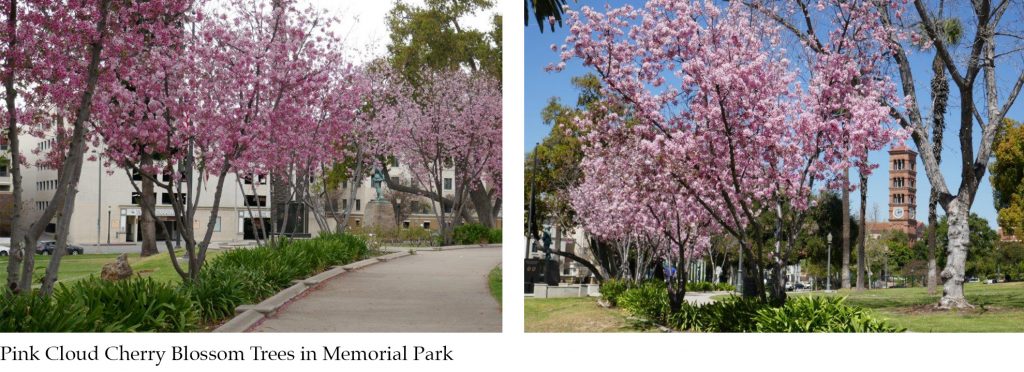
In 2012, the Consul General of Japan in Los Angeles contacted Pasadena to let them know that an unlimited number of free bareroot Pink Cloud cherry trees were being made available to select cities in Southern California that had relationships with cities in Japan. The City Council then instructed the sister city committee to obtain 50 trees. These trees were procured and donated by the Huntington Botanical Garden to Pasadena.
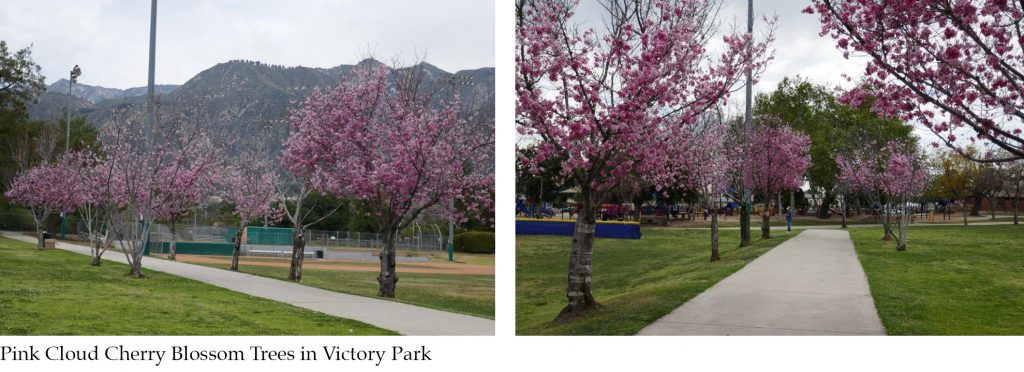
The trees were planted in various parks in Pasadena in 2012 to commemorate the 100th anniversary of when 3000 flowering cherry trees, a gift from the Mayor of Tokyo Japan to the United States were planted in Washington D.C. in 1912. These trees were meant to celebrate the growing friendship between the people of Japan and the United States.
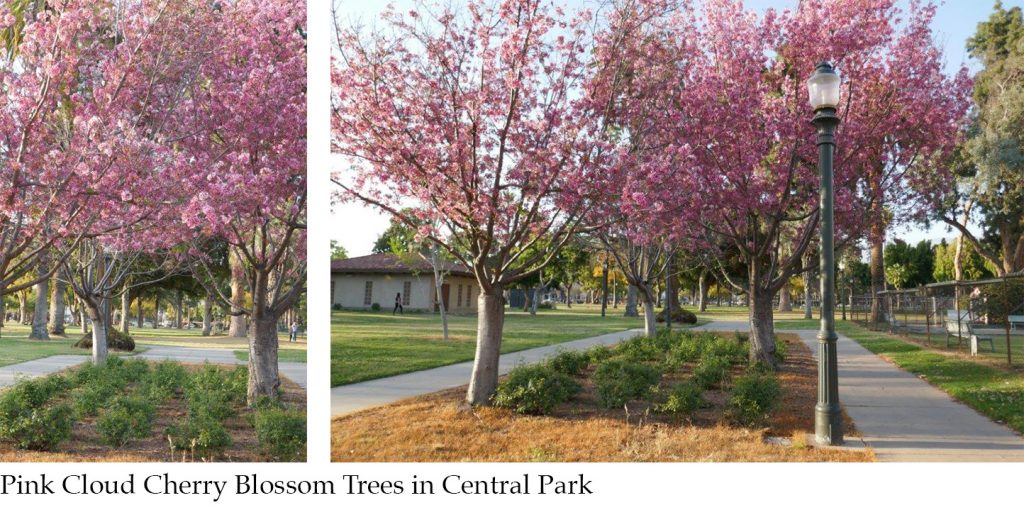
This Pink Cloud variety grows 15 to 20 feet tall and as wide with a willowy round shape. The leaves are simple, alternate and toothed. The flowers have 5 petals and appear before the leaves in late March and early April. Flowering cherry trees require full sun, good air circulation and a well-drained soil rich in organic matter. They also require some pruning during the winter.
There are many other cultivars of flowering cherry trees with blossoms ranging in color from white to dark pink. These trees produce some of the most dramatic blooms during the spring. The bloom season unfortunately lasts only a few weeks. Most cultivars live 30 to 40 years with a few exceptions such as the ones in Washington D.C. where some of the original trees that were planted in 1912 are still alive.
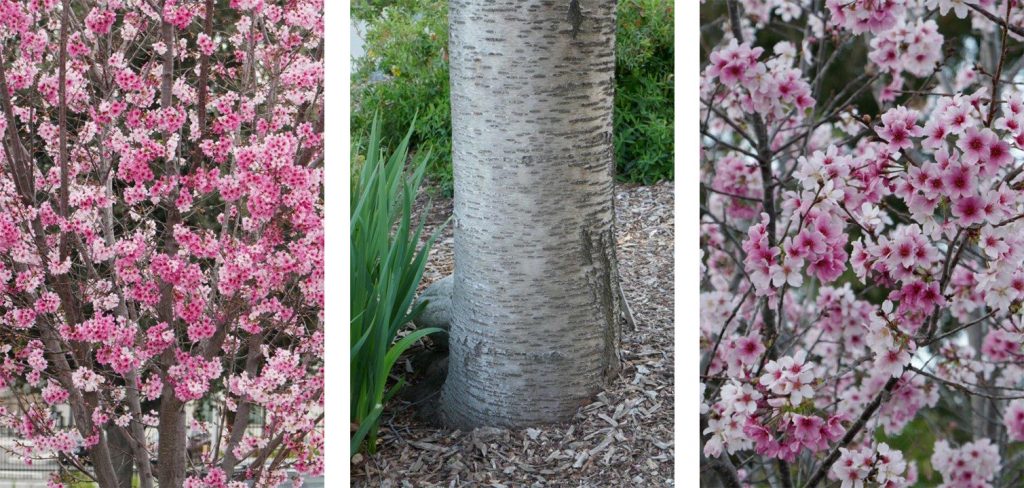
The sight of cherry blossoms is so spectacular people travel from all over to attend the Cherry Blossom Festival in our Nation’s capital. If you can’t make it to Washington D.C. or Japan where the tradition of celebrating the cherry blooms goes back thousands of years, you can still be dazzled by the beauty of the ones growing here in Pasadena.
Article and photos by Emina Darakjy
March Tree of the Month
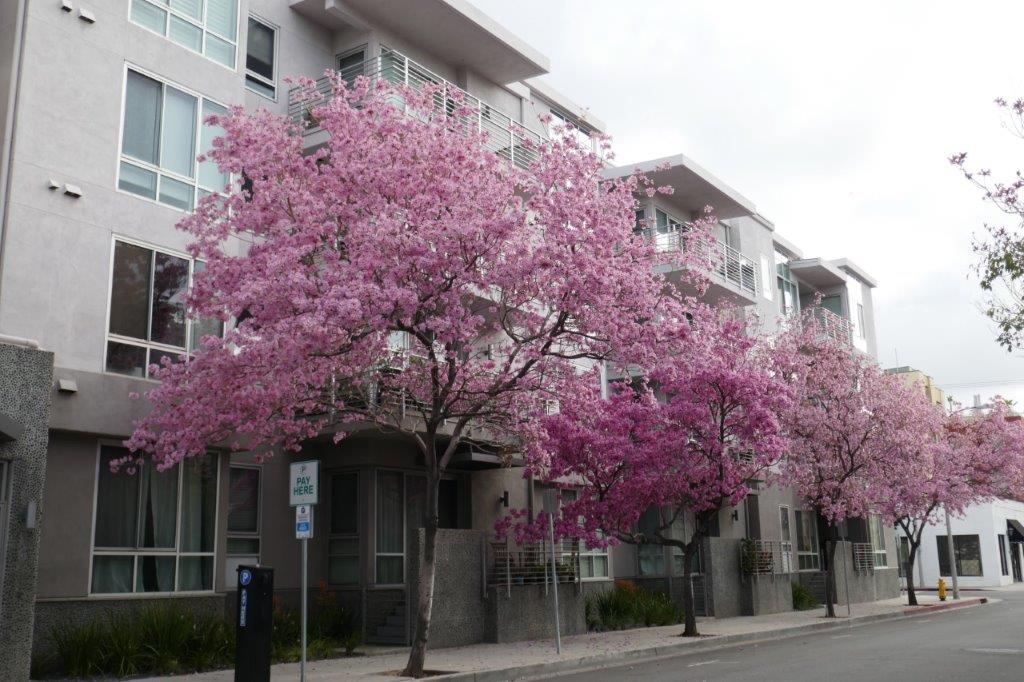
HANDROANTHUS HEPTAPHYLLUS, (Pink Trumpet Tree)
Synonyms: Handroanthus avellanedae, Tabebeuia impetiginosa
We are very fortunate to have several specimens of this tree growing throughout Pasadena. Several years ago, Pasadena Beautiful planted about 230 Tabebeuias on Colorado Boulevard from Wilson Street to Roosevelt Avenue.
This time of the year the trees put on an extravagant display of bright pink flowers that make drivers want to pull over to take a picture. Other areas where you can find these attractive trees growing in Pasadena are on Union Street between Arroyo Parkway and Fair Oaks Avenue; on Dayton Street between Fair Oaks Avenue and Pasadena Avenue; on Holly Street between Fair Oaks Avenue and Raymond Avenue and on Oak Knoll Ave from Walnut Street to Green Street.
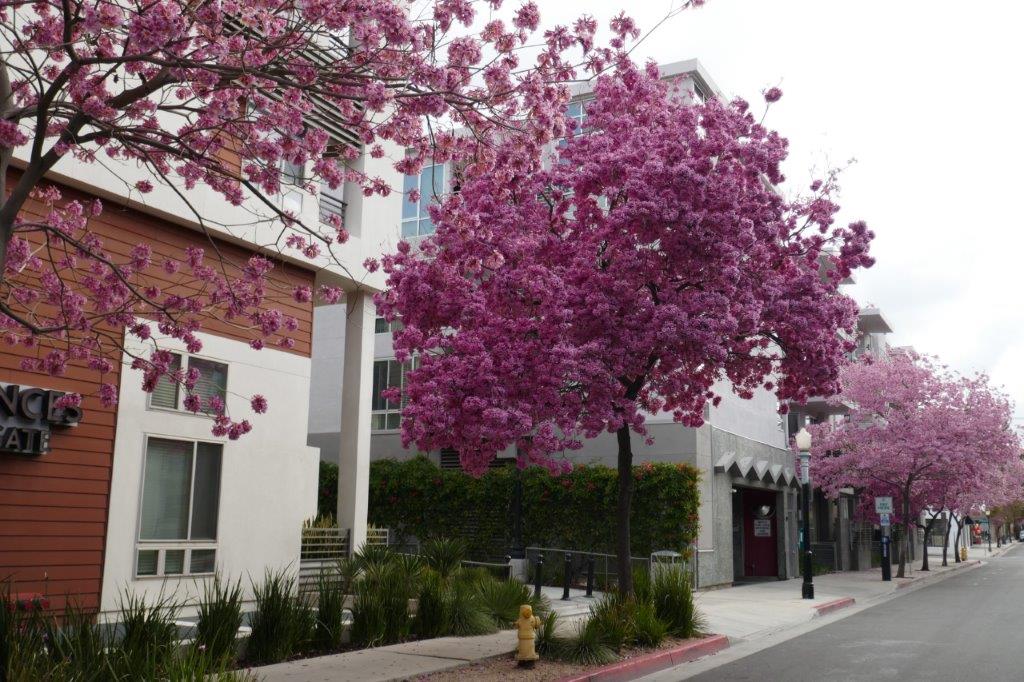
This is a small to medium sized tree, 25 to 50 feet tall and almost as wide, with a light straight gray trunk, native to the tropical areas of Mexico, Argentina and Brazil. The tree is partially deciduous. Heavy clusters of showy pink flowers with a yellow throat appear on leafless branches in early spring, the spectacular display of flowers is followed by foot long seed pods that hang onto the tree until winter. This tree does better in warmer areas, is considered drought tolerant once established with no significant pest or disease problems and is suitable for planting under power lines, in parkways, parks and as an accent in a garden.
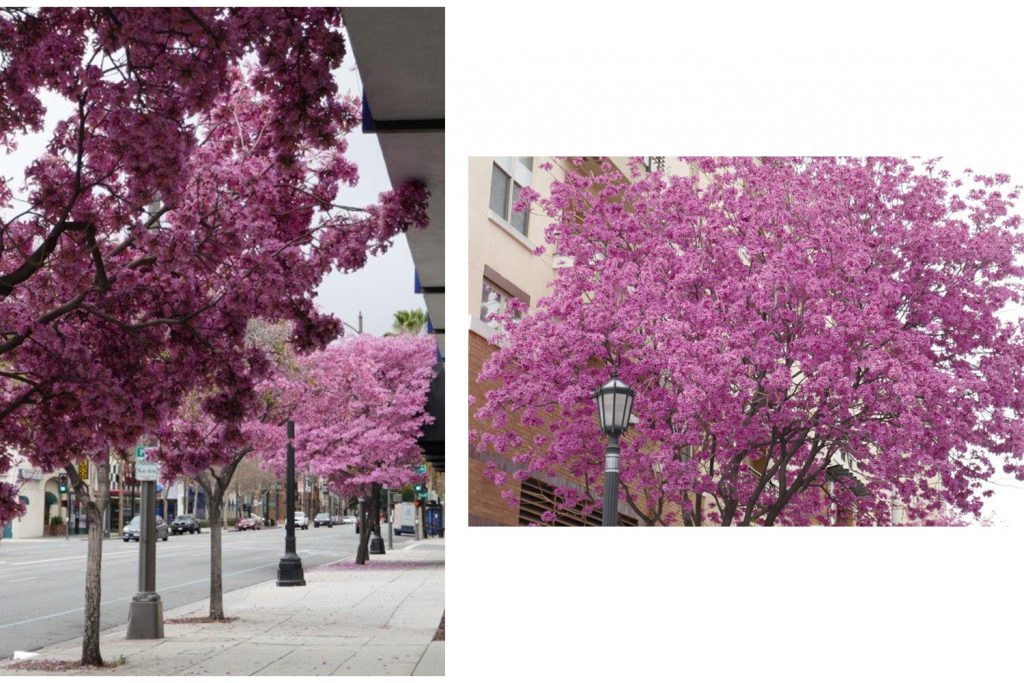
I feel it is worth sharing with you the little-known fact behind how we got to know the Tabebeuia tree. According to James E. Henrick the Senior Biologist and Curator of the Living Collection at the Los Angeles County Arboretum in Arcadia, the desire to introduce the Tabebeuia to Southern California originated with Dr. Russell J. Seibert, director of the Los Angeles County Arboretum from 1950 to 1955.
Unfortunately, seed sources from South America at the time were not very reliable. However, that did not deter Dr. Samuel Ayres, Jr., president of the board of trustees of the then California Arboretum Foundation, Inc., from gathering seeds of different species while vacationing in Brazil between 1953 and 1955.
As it is now, the Arboretum was a testing ground for new plants to be evaluated before they are introduced to the nursery trade. As a result of these seed gatherings, the following Tabebeuias were evaluated and produced at the Arboretum and given to local nurseries to propagate and sell to the public.
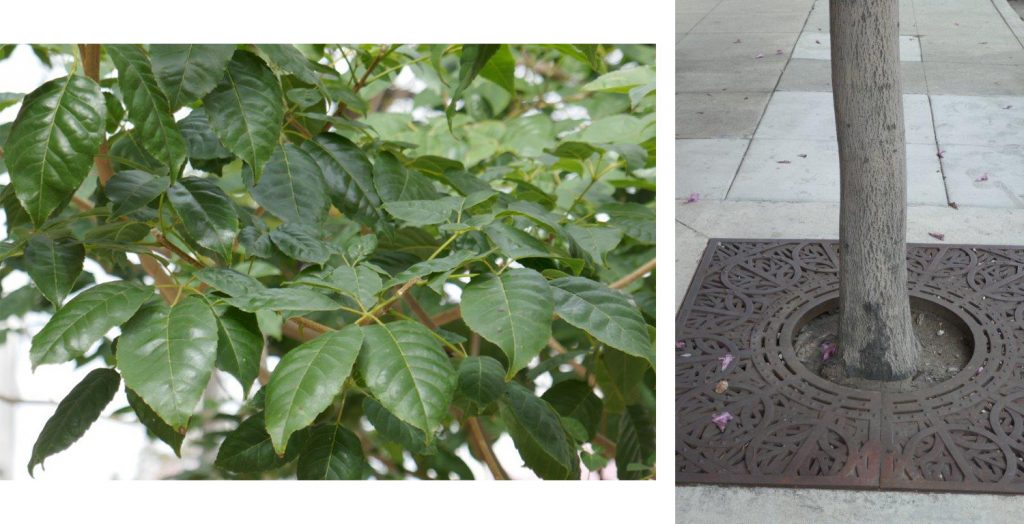
The Tabebuia chrysotricha commonly known as the golden trumpet tree with eye catching bright yellow flowers was the first to come out in 1964. The Tabebeuia impetiginosa commonly known as pink trumpet tree seen in the present photos, followed in 1979. The Tabebeuia impetiginosa ‘Pink Cloud’ with its very light pink flowers came out in 1984. And the Tabebeuia impetiginosa ‘Raspberry’ with its lavender to dark pink flowers was introduced in 1986. Beside the above-mentioned varieties there is another gorgeous one, Tabebuia x ‘Apricot’ with beautiful apricot color flowers, it too was produced by the Arboretum in 1970 but has not been introduced yet with plans to do that in the future.
Article and photos by Emina Darakjy
